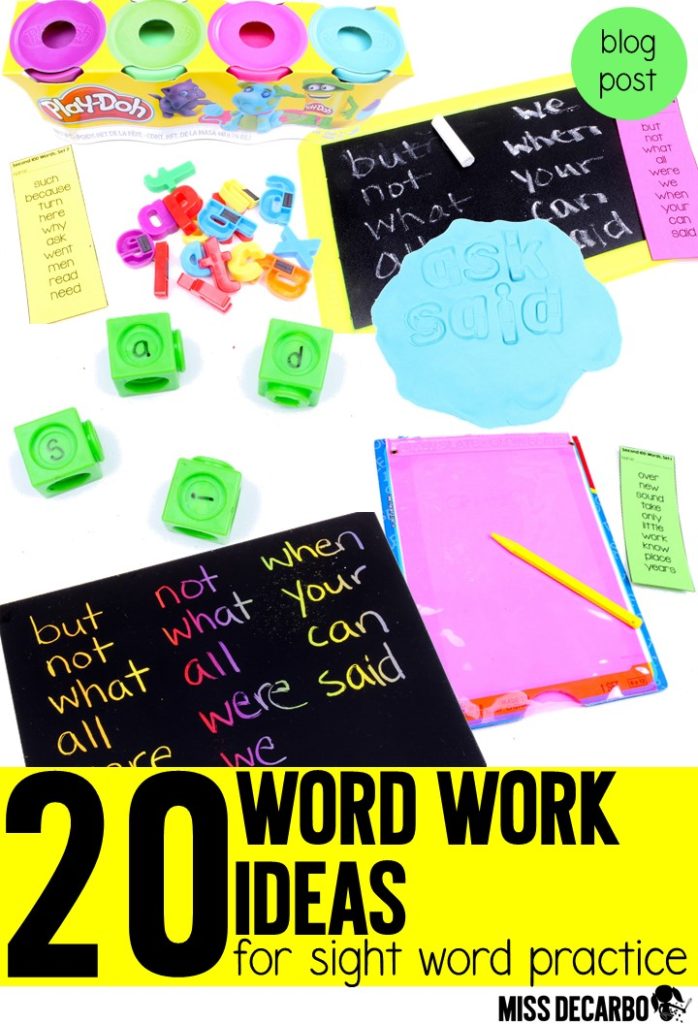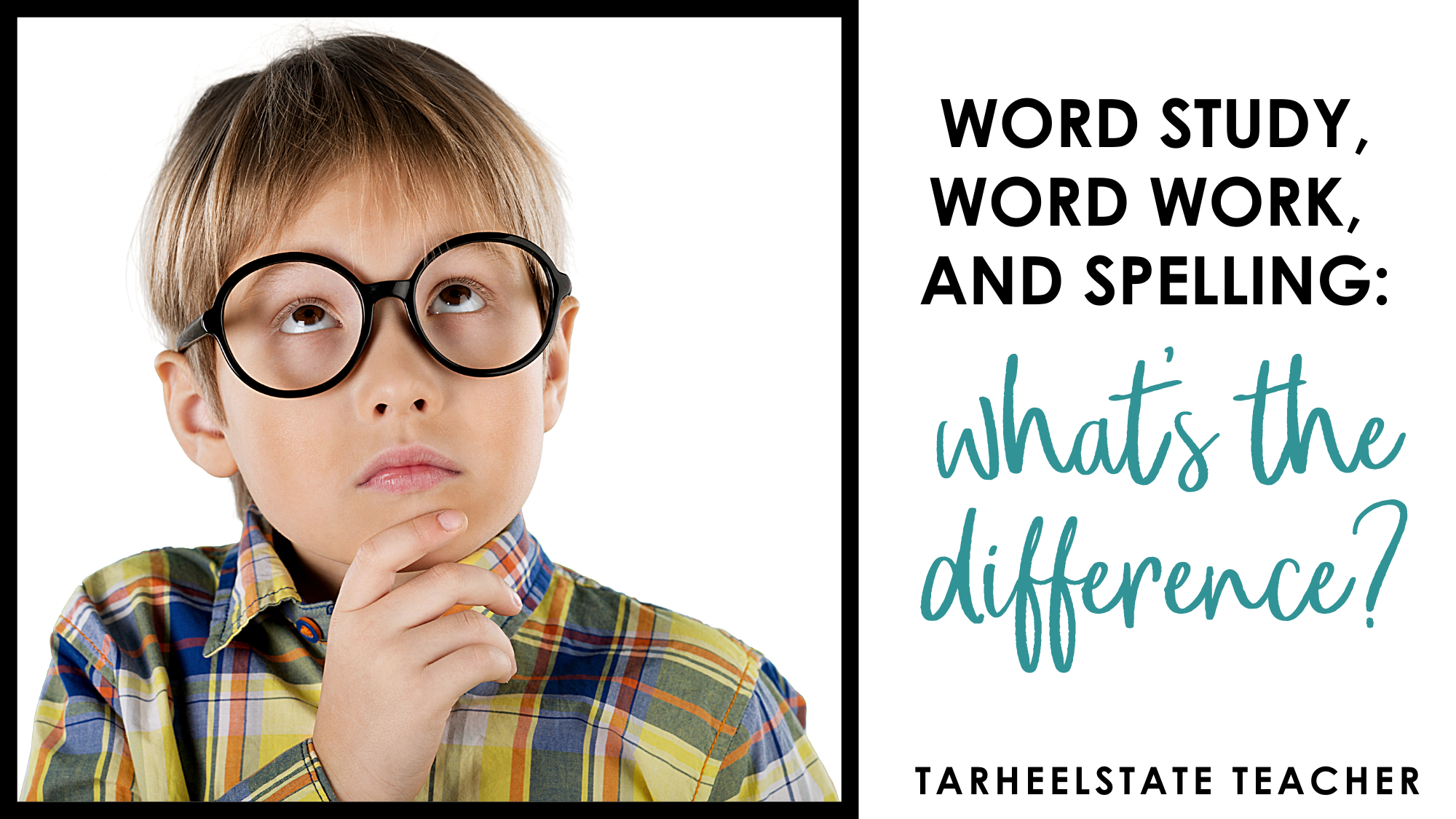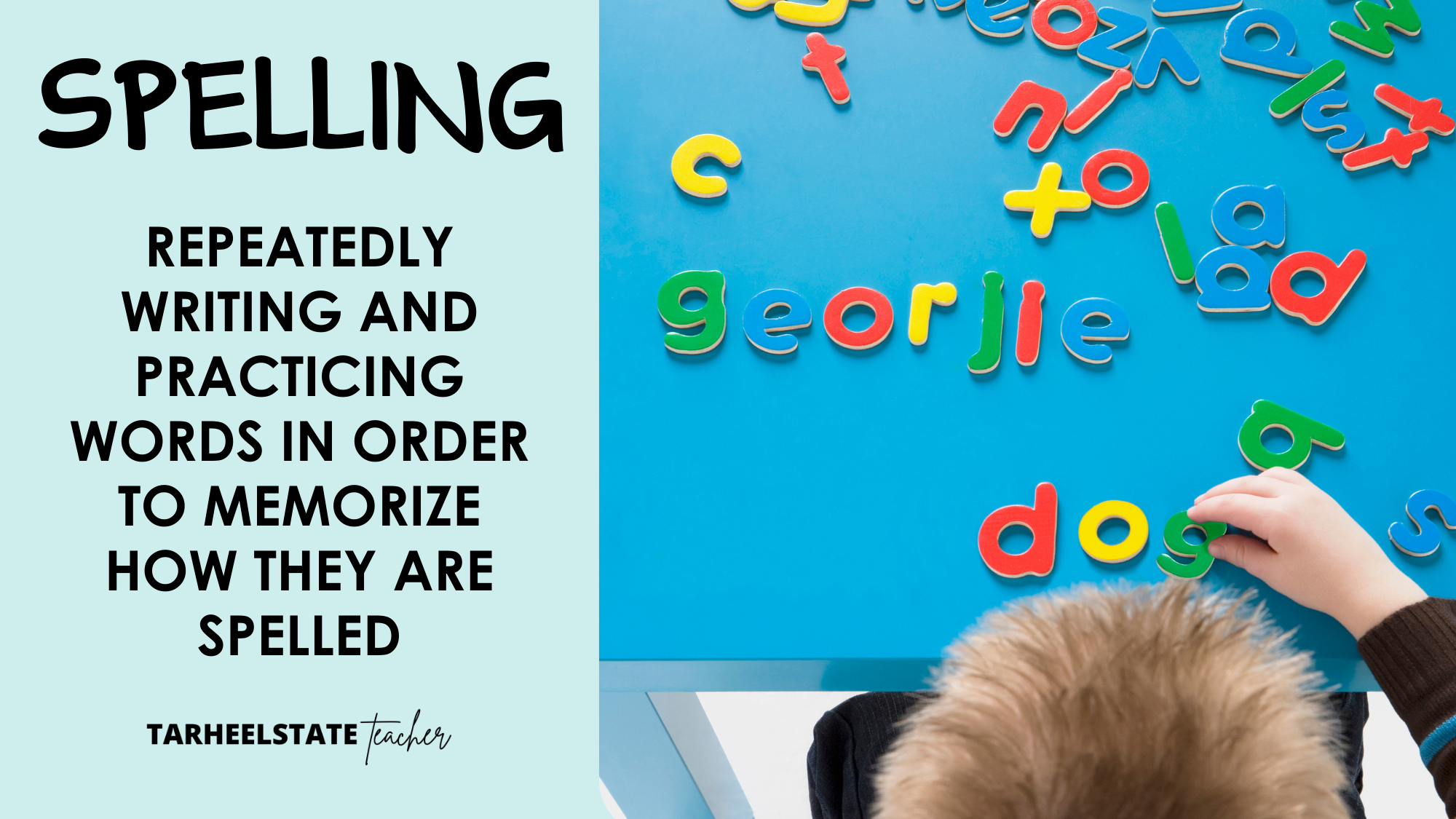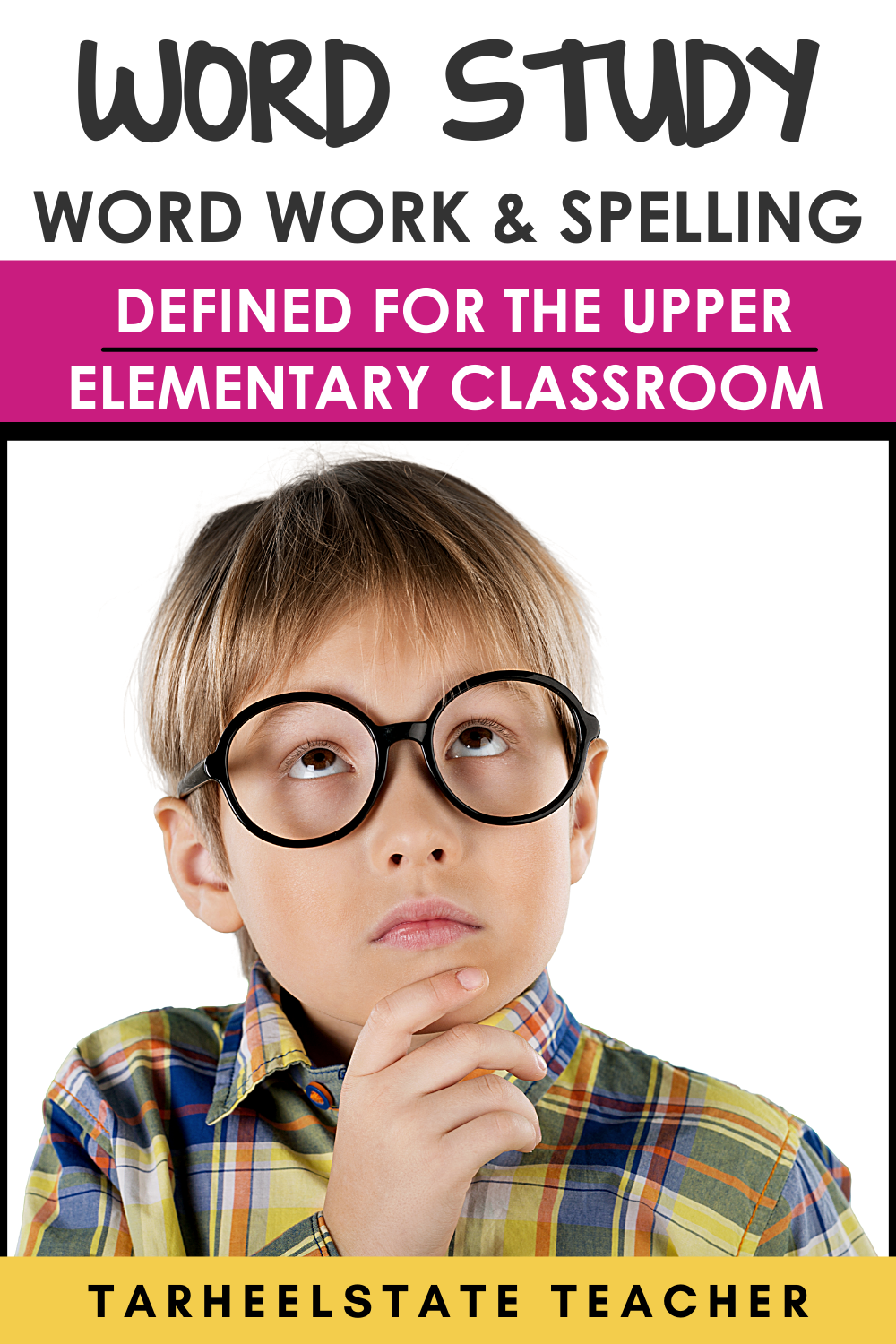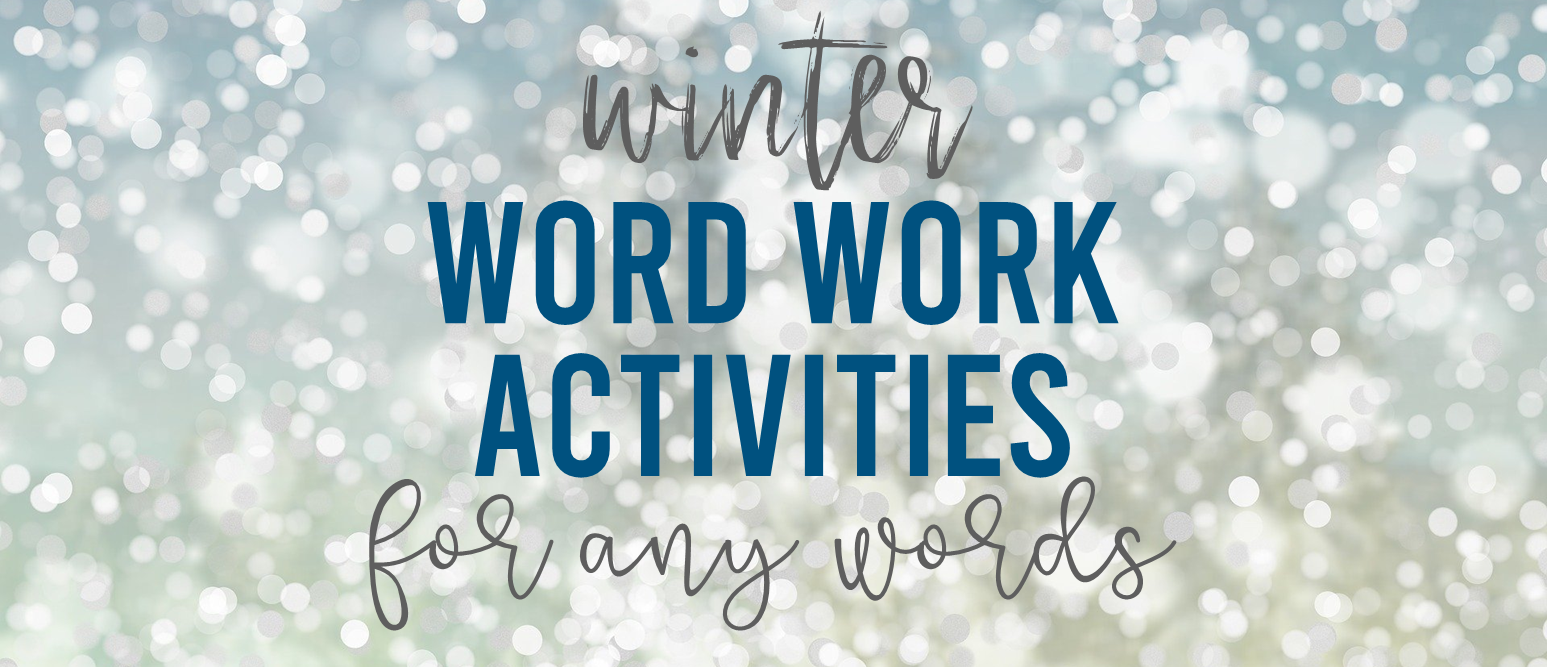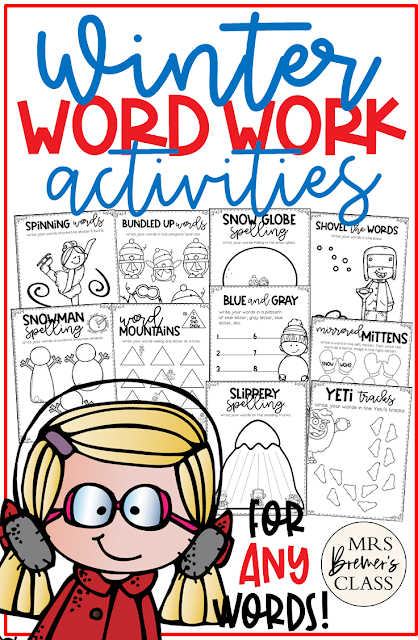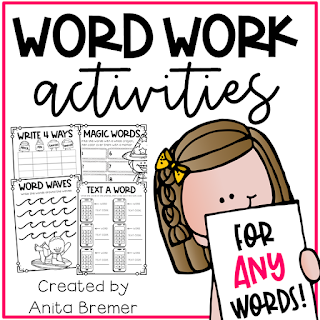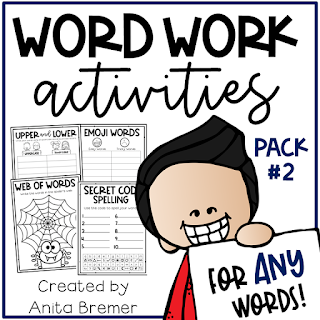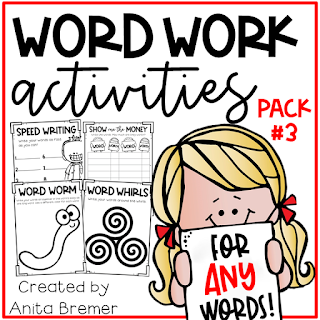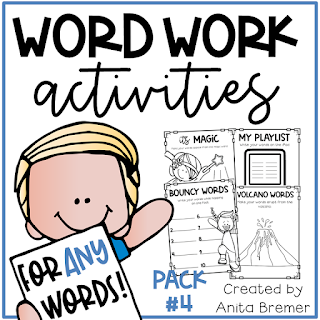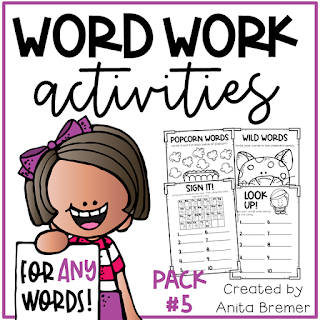Word study, word work, and spelling…confused about the difference and why it matters in your upper elementary classroom?! These three types of word learning structures often get thrown around interchangeably in the upper elementary teaching world, but they have important differences in approach and purpose. You may have landed on this blog post as a new teacher who really wants to know what distinguishes each practice, as a veteran teacher who’s curious to see if our definitions match, or as someone who falls in between. While word study, word work, and spelling have quite a bit of crossover, there are also some fundamental differences that we should take into consideration.
I was always an A+ speller, but I had everything going for me in that department—I loved to read, my ability to memorize was fantastic, my enjoyment of all things school and my type-A personality allowed me to thrive on practice worksheets, I loved having my mom call words out to me to spell, and I gave myself my own spelling tests to make sure I would do well on the tests…heck, I probably even had index cards to help myself focus on any words with tricky spellings. How many of your students sound like that kind of kid?!
In recent years there has been a shift away from traditional spelling programs where students focus solely on memorizing a list of (possibly) random words in order to perform well on a spelling test. Teachers and parents alike often complain that students are able to perform well on spelling tests but continue to misspell words in their written work. It’s like cramming for a test and then forgetting much of the information once time has passed.
Before we get into my recommendations for an upper elementary word study/spelling program that works, let’s make sure we have a good understanding of the nuances of spelling, word study, and word work.
WHAT IS SPELLING?
Traditional spelling instruction focuses on learning to spell words correctly given a list of words. In upper elementary, how words end up on a students’ spelling list can run the gamut. The word list can be based on a spelling pattern, personalized based on a sight-word assessment, derived from books students are reading, come from content area vocabulary, or a combination of sources. Language Arts textbooks and literacy curriculums often include lists of spelling words and lessons for students to complete but they are often not based on developmental spelling levels or individual students’ needs.
In hopes of differentiating spelling lists, teachers sometimes have students choose half of their words from a class word list and half of their words from a “personal” list of words that students need to master.
While a spelling program can teach phonics and word pattern concepts, the focus is often on memorization, spelling tests, and moving on to new words the following week. Spelling activities often involve repeated activities and practice writing words so that students can spell them correctly when they are tested on them—think “three times each,” rainbow words, word pyramids, ABC order, and more as ways to make it fun for students to write their spelling words again and again.
WHAT IS WORD STUDY?
In word study programs, students are guided to discover and make generalizations about patterns in words and how words work. Word study aims to improve students’ ability to read words, spell words accurately, and understand the meaning of words, including how adding different word parts modify word meanings. “Studying” words is a foundational aspect of word study and moves away from a strict focus on memorizing how words are spelled.
For example, students participating in a word study block may be learning about words that end in -ck and -ke. Through reading, sorting, searching for, and writing words that fit in this particular category, students are guided to discover that most words ending in -ke make the long vowel sound, while most words ending in -ck make a short vowel sound. In word study, students move from noticing similarities and differences in word patterns, sounds, and spellings to being able to verbalize a common rule or way words with those patterns and sounds function.
While spelling words accurately is a goal of word study, so is applying the knowledge of word patterns to spell other words that also follow the spelling pattern; transferring their learning to spell new words is a key goal of word study.
Differentiation is another cornerstone of a true word study program. In classrooms where word study is implemented, students are assessed with a spelling inventory to see where they are in their understanding of phonics and word patterns. The inventory contains a variety of words and increases in complexity to identify students’ mastery of sound patterns and ability to represent the sounds they hear through spelling.
Based on the assessment, students are grouped by their developmental level. For example, students who don’t show a solid understanding of long vowel patterns would not be studying how prefixes and suffixes impact a word’s meaning in the scope of word study (although, the teacher may implement whole group lessons focused on Greek and Latin roots and students will surely encounter those kinds of words in content areas like science and social studies.)
Word study often involves tactile sorting of words on word cards where students group words based on spelling patterns and sounds. Students then document their word sorts by copying it down on paper. This practice helps students think about and come up with ideas about how the words work.
WHAT IS WORD WORK?
Word work is largely used with pre-readers and early readers in preschool and lower elementary grades with a focus on phonics, sight words, and spelling—all critical for our earliest readers! It consists of a variety of teacher modeling, hands-on activities, and games that encourage word building and word reading. In my experience, word work has usually been a component added into students’ guided reading time. Many lower grades teachers try to add a few minutes of word work at the start or end of most of their guided reading lessons.
Word work should bring to mind images of students building words and writing different words repeatedly. During word work, students may learn about word families like -at and -an. They can practice reading and writing new words by changing the beginning consonant (pat/mat/cat and fan/man/pan). Word work is also a time to help students memorize high frequency words that are key for developing as readers. Playing with words and manipulating parts of words is a key component of word work.
WHAT’S AN UPPER ELEMENTARY TEACHER TO DO?
I have found that a well balanced word-learning program has the best aspects of word study, word work, and spelling AND as the teacher, you should be well aware of your goals for whichever program you choose to implement.
I can’t not say this—word study/spelling time needs to be differentiated based on students’ developmental levels. If not, in my experience spelling time just feels like a punishment to some students and a waste of time for others. The days of having all students in a class or grade level working to master and spell the same word list should be a thing of the past for upper elementary classrooms. And, when your students’ assignments are based on their developmental level, they’ll be more eager to participate and have a growth mindset about their spelling and word attack abilities.
Next, we can use elements of word work to bring fun and engagement to our word study program. Games and activities can give students many opportunities to see and work with words and word patterns. These word-work-like experiences will naturally support our upper elementary students in making generalizations about spelling patterns, word pronunciations, and word meanings.
My ultimate recommendation for upper elementary teachers is to create an inquiry-based word study routine where the foundational goal is for students to learn to generalize the consistencies they notice in words in ways that help them become better readers and writers. This routine should incorporate 1-2 days of playing with words and sounds and 1-2 low-stress days that are focused on spelling words accurately. #teachersonamission!
Because I’ve realized that the hands-on FUN was missing from my word study routine, I’ve spent 2021 running down the long path of creating word study games and activities for all levels of word study. These games and centers are aligned to Words Their Way, but can complement any word study program where the focus is on word patterns and sounds. See what these are all about here! With the addition of board games, card games, spinners, and picture board activities, you are sure to find the spark of joy in word study that I’ve felt all these years!
Struggling to picture what this would look like on paper?! Don’t worry! I’ve got you covered in some upcoming posts about word study routines and schedules! Stay tuned! (Or, better yet, grab your FREE Word Study Terminology download and you’ll be updated when I publish new posts about word study!)
HELPFUL RESOURCES FOR UPPER ELEMENTARY WORD STUDY

We have developed four resources that will help you teach word work and spelling to your students in a fun and engaging way. No more pre-test Mondays and post-test Fridays! That is a thing of the past!
Here are the resources that will be of benefit to you in the classroom:
1. Word Work Activity Cards

Also included in the document is a handy check off sheet so you know what choice your students have made with the activities.
2. Word Work Spelling Choices

3. Word Work Task Cards: Four Pictures Equals One Word

- There are 50 “Challenge” cards included. The cards work best if they are printed off on a heavier paper and then laminated. The cards can also be bound together for a station or they can be stacked loosely also- whatever works best for you.
- Each card contains four pictures. Students are to look at the pictures and decide what they have in common. The letters to choose from are listed towards the bottom of each card. For most cards, not all 11 letters will be used. The number of letters in the word are located at the very bottom of each card.
 4. Word Work 10 Day Spelling Program
4. Word Work 10 Day Spelling Program
Here is a great resource to use when teaching your students patterns in spelling or word work.
Here’s what is included:
1. Description cards for students that include the task that they have to do for each of the 10 days.
2. A student packet where the students show evidence of their word work or spelling that you can collect.
3. A quiz on Day 10 to check accuracy and mastery of a spelling pattern.
These resources have helped our students become better spellers, and we know they will help your students too!
Pin for later:
Spelling and Word Work are essential parts of language learning in the primary grades. I love to make this task FUN for my students while real LEARNING takes place.
I’ve used this during our Daily 5 time of Working on Words, but these activities can be used for ANY word-learning subject!
WINTER THEMED WORD WORK / SPELLING ACTIVITIES FOR ANY WORDS
As mentioned, they can be used for absolutely ANY word learning, including:
names
sight words
spelling words
vocabulary words
Daily 5 activities
or whatever you like!
No prep! Just print and go! Perfect for centers and sub plans.
Many activities allow for practice with options of 5-20 words, to suit your needs!
A must have for Kindergarten to Third Grade!
Find more packs for ANY words here:
When autocomplete results are available use up and down arrows to review and enter to select. Touch device users, explore by touch or with swipe gestures.
Check out this board for word work and spelling ideas, activities, and resources.
·
Similar ideas popular now
Word Work Mats for Word Work Centers
Activities for Compound Words
Word Work and Spelling Activities
Creatively Teaching First
Word Work and Spelling Activities
Creatively Teaching First
Activities for Word Work and Spelling
Creatively Teaching First
Organize guided reading and math rotations, stations, and small groups.
Creatively Teaching First
Alphabet activities for preschool and kindergarten
Creatively Teaching First
Use word work Boom Cards for distance learning
Creatively Teaching First
Engaging word work activities and spelling ideas
Creatively Teaching First
Engaging word work activities and spelling ideas
Creatively Teaching First
Engaging word work activities and spelling ideas
Creatively Teaching First
Plan your phonics instruction and teach your students CVC word families through these hands on word sorts.
Creatively Teaching First
Plan your phonics instruction and teach your students CVC word families through these hands on word sorts.
Creatively Teaching First
Plan your phonics instruction and teach your students CVC word families through these hands on word sorts.
Creatively Teaching First
7 engaging word work activities and centers to support literacy instruction in a primary classroom.
Creatively Teaching First
7 engaging word work activities and centers to support literacy instruction in a primary classroom.
Creatively Teaching First
7 engaging word work activities and centers to support literacy instruction in a primary classroom.
Creatively Teaching First
7 engaging word work activities and centers to support literacy instruction in a primary classroom.
Creatively Teaching First
7 engaging word work activities and centers to support literacy instruction in a primary classroom.
Creatively Teaching First
7 engaging word work activities and centers to support literacy instruction in a primary classroom.
Creatively Teaching First
7 engaging word work activities and centers to support literacy instruction in a primary classroom.
Creatively Teaching First
7 engaging word work activities and centers to support literacy instruction in a primary classroom.
Creatively Teaching First
7 engaging word work activities and centers to support literacy instruction in a primary classroom.
Creatively Teaching First
7 engaging word work activities and centers to support literacy instruction in a primary classroom.
Creatively Teaching First
7 engaging word work activities and centers to support literacy instruction in a primary classroom.
Creatively Teaching First
In this post, I’m going to share TWENTY word work ideas for sight word practice in your classroom. Before I begin the fun, I want to quickly explain how my word work time is implemented, so that you can better understand how, when, and why I use these ideas with my students.
When Does Word Work Take Place?
I actually have three “word work times” in my room. One word work time takes place during a mandated teaching time using my district’s phonics program we adopted. All of my students receive hands-on experiences and engage in lessons that involve making, breaking, and building words with various phonetic patterns. Another “word work time” takes place at the small group table. This word work time varies depending upon the students I’m working with. One group might be working on CVC words while another group is sorting words with various diphthong patterns. These two word work times I have listed are rooted in phonemic awareness and phonics instruction. The third “word work time” in my classroom takes place during Daily 5 time. If you’re not familiar with the Daily 5, it is a management routine that takes place while you are teaching small groups. (To put it simply, it’s what your students are doing while you are teaching small group reading.) One of the activities students are engaged in throughout the week is word work. This is similar to having word work as part of your literacy centers.
What Words Do Students Practice During Word Work?
Several years ago, I made the decision to dedicate this “Daily 5 word work” time strictly to sight word practice. I found that while I had been hoping (and encouraging and motivating and bribing and begging) my students and families to practice spelling and reading their sight words at home, many simply weren’t. They needed sight word spelling practice built into our school day. We know sight words are spelled irregularly, so our students need the opportunity to practice writing and reading them over and over (and over and over and over and over) again!

In the photograph above, you can see that my students have sight word lists stored in little library pockets on a bulletin board in my room. That’s because the sight words my students practice reading (and spelling) during word work are differentiated for every student. How? By using a student-friendly sight word assessment program. When it is time for a student to go to our word work center, the student will grab his or her list of words, take a word work bin from our bookshelf, and get started! (When the photograph above was taken, I was still developing this resource for other teachers, so my students simply wrote their own list out by hand. Since then, I have made this a much easier process by creating sight word lists for the first 500 Fry Sight Words.) You can grab pre-made sight word lists in my Sight Word Assessment and Word Lists resource by clicking HERE. You can read ALL about how I differentiate and assess sight words by reading this blog post: Assessing and Differentiating Sight Word Recognition. The kid-friendly word lists now look like this:
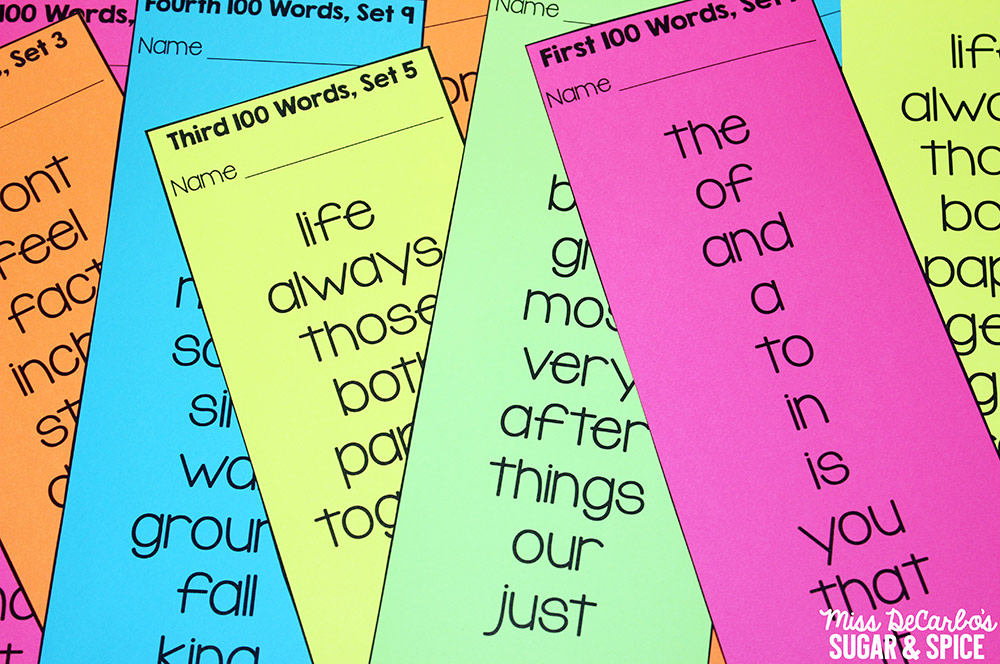
I have six word work “bins” in my classroom. Each bin is filled with exactly the same word work activity! After a week or two, I switch out the materials in the bins with something new. This keeps word work fresh, new, and exciting every week, because the activity is always changing throughout the year. You can read even more about how I organize all of my word work materials (and why I do it the way I do) by clicking on my word work organization post HERE.
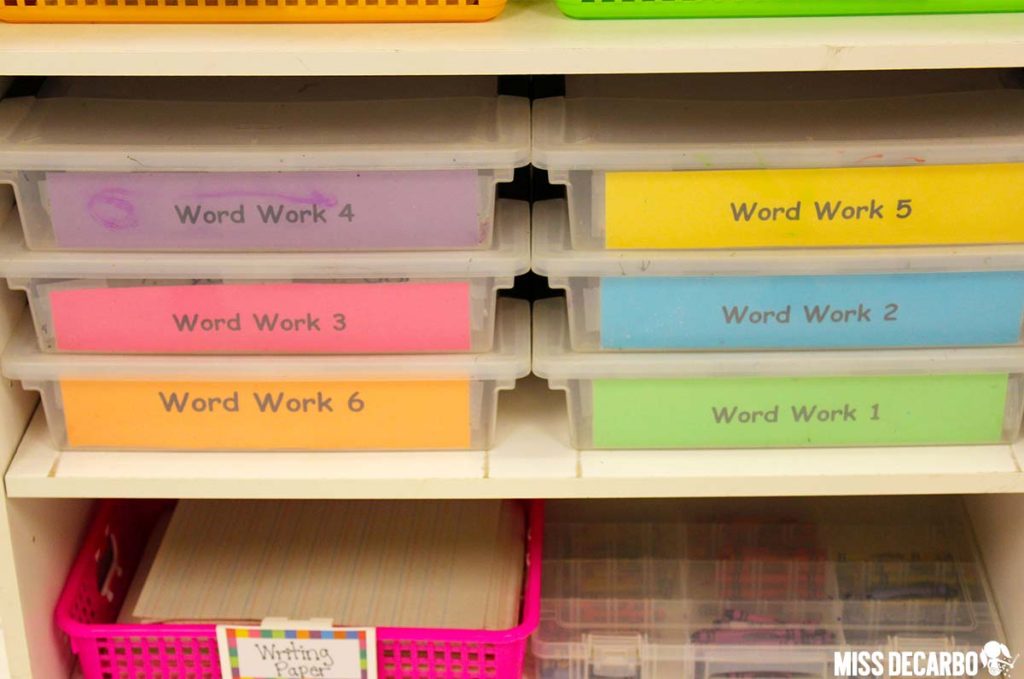
For your convenience, I’ve added links to the materials I talk about within the blog post. These are Amazon Affiliate links. This just means Amazon tosses a few cents my way if you make a purchase with the links – at absolutely, positively, no extra cost to you! These little links help me to continue sharing ideas with you on the site. Here’s an example: The bins I use for work work can be found here.)
What do your students do during word work?
This a question I have frequently been asked by teachers and friends, and it is the entire reason I sat down to write this blog post! Last month, I shared how I introduce new sight words to my students. We talked about the critical importance of context during sight word instruction. You can read all about sight word introduction and instruction in this post: Three Ways to Help Students Who Struggle with Sight Words. Today’s post comes after that initial introduction. Today, we’re going to talk about all kinds of FUN ways to practice spelling sight words! In fact, I’m about to share TWENTY fun word work ideas that my students LOVE in my classroom! You may have heard of several of these ideas already, but I do hope that you find new ones, too! If anything, I hope you will enjoy having a BIG list of word work ideas all together, with photographs, in one convenient place! Are you ready? Let’s do this!
(Side Note: We do not use anything fancy in my classroom to record our words on. I don’t print out and waste tons and tons of printable pages for recording sheets every week. Instead, we just use plain paper, or those really cheap 10 cent notebooks that you can buy at Walmart at the beginning of the school year. These become their Word Work Notebooks. Then, students can work in their notebooks all year, and I am not running off tons of copies every week. Easy right? Simplicity is beautiful, my friends!)
Word Cubes
Write lowercase letters on unifix cubes. Students work to “build” their sight words by linking together the letters they need to spell the word. This works just like magnetic letters. I love this word activity because it helps struggling students understand that by physically combining and linking letters and sounds together, words come to life!
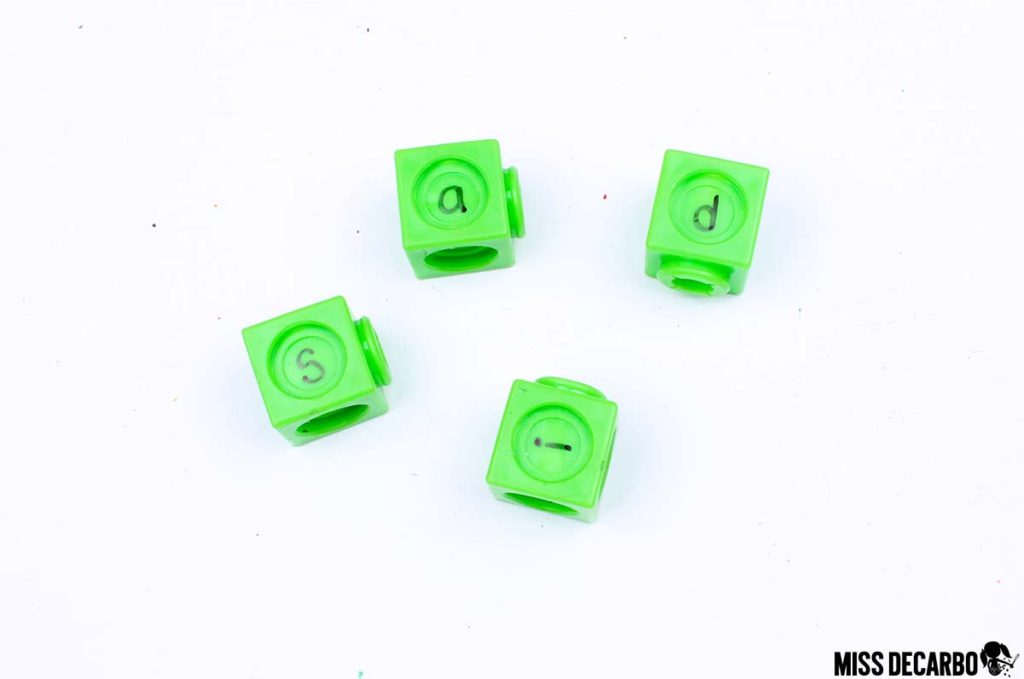
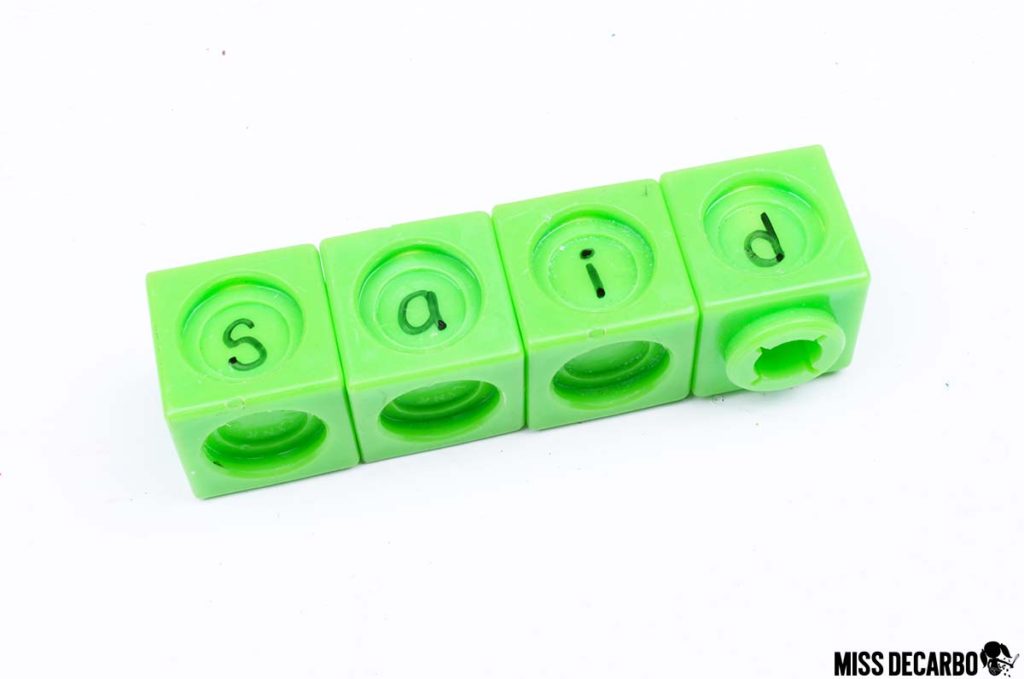
Watercolor Words
We LOVE using watercolor paints to practice our sight words. I take clear cups and draw a line with a black sharpie about 1/4 of an inch from the bottom of the cup. I teach my students how to fill the cup of water to the line (It is SUCH a small amount of water.) and use that during their word work time. (Paint Trays can be found by clicking here.)
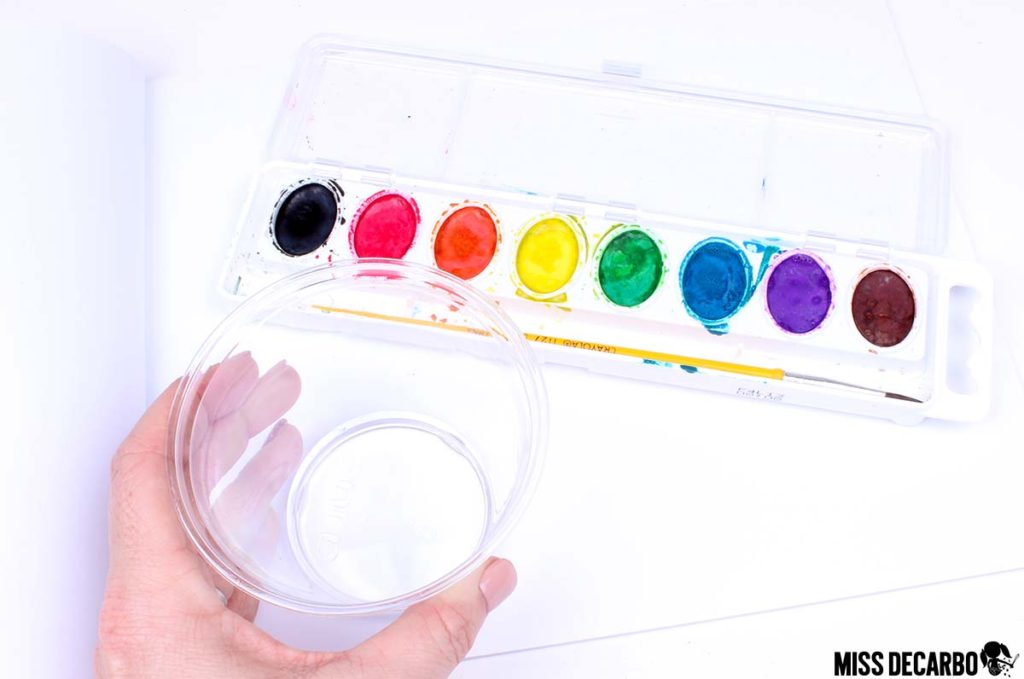
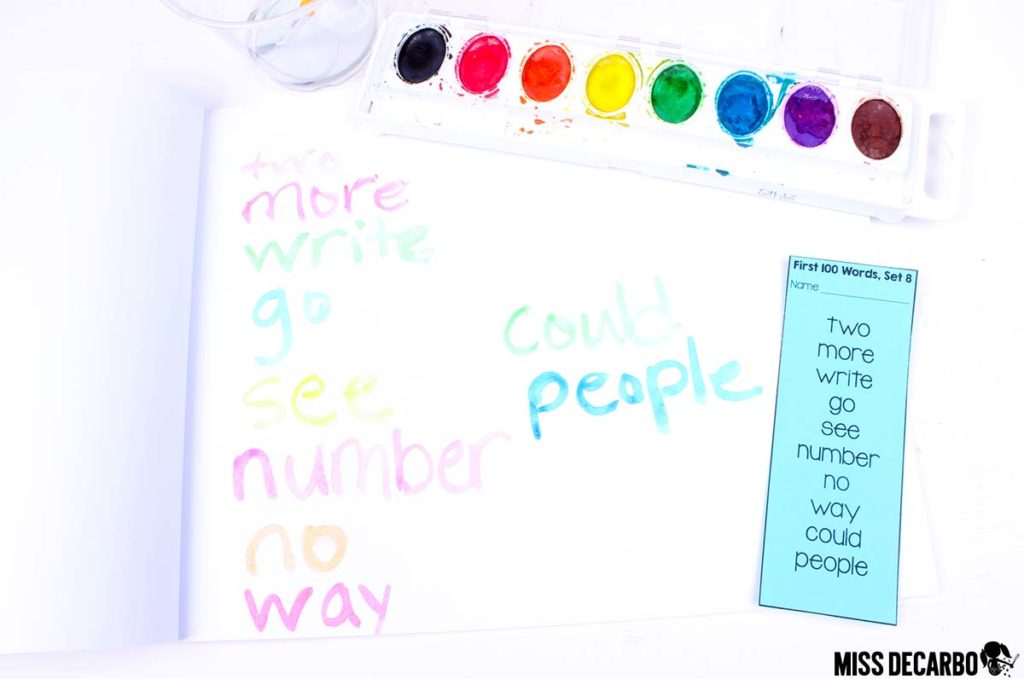
Scratch Words
Please brace yourself for the day you add Rainbow Scratch Paper to your word work bins. Why? Well, because your students will think you are simply the most amazing person in the universe. This is a word work activity my students FLIP over. (Tip: The paper can be expensive because it is not something that can be reused over and over again, so I actually cut my paper in half to get double the amount! We really only do this word work activity for one or two weeks throughout the school year.) I tell my students that they get to use their one precious piece of paper during their word work time, so they have to FILL it with as many sight words as possible on their list. My students love seeing how many sight words they can fit and “scratch write” on their paper. (You can find the Rainbow Scratch Paper I use by clicking here. The Melissa & Doug company also have post-it sized pieces that you can find here.)
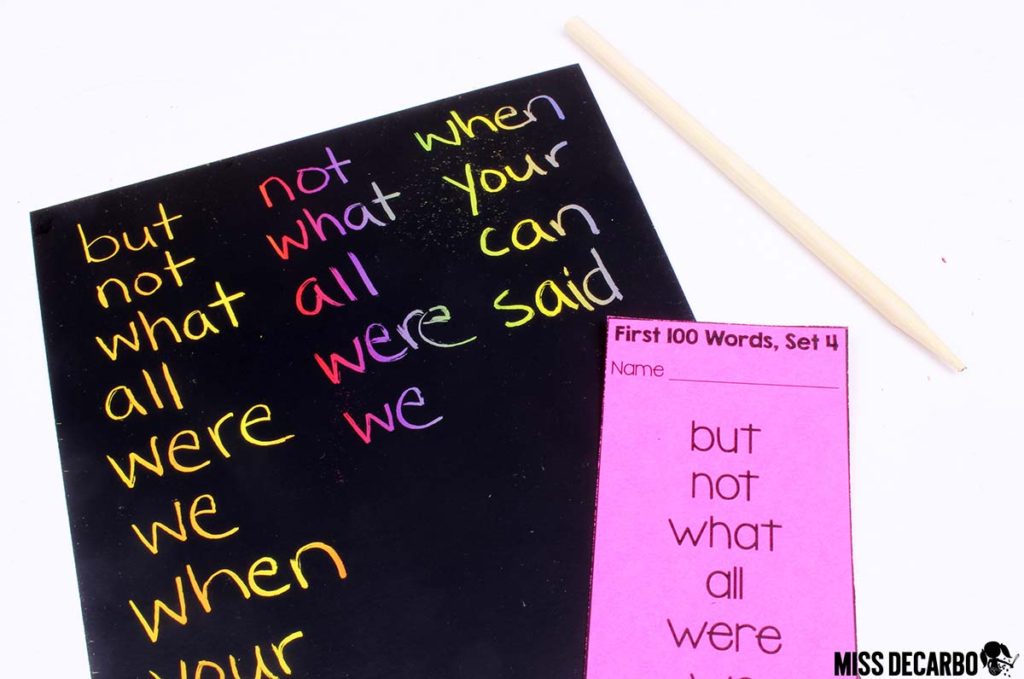
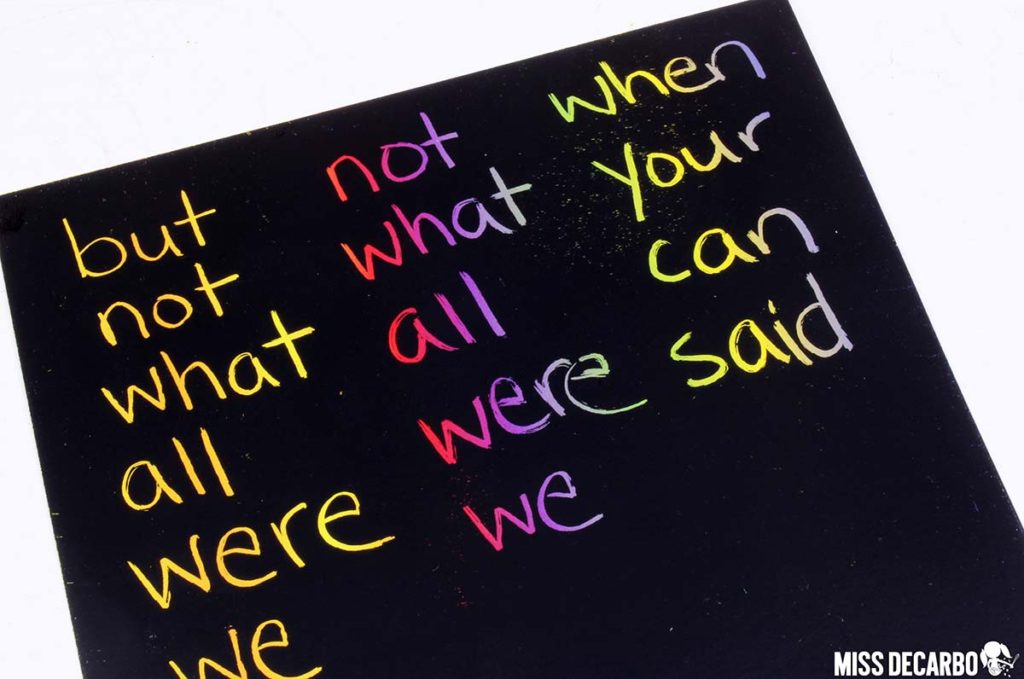
Rainbow Writing
This is a classic word work activity, and I can’t write a word work blog post without including it. To Rainbow Write your sight words, your students will choose three colors of crayons (markers and colored pencils work, too). The students write the sight word with one color, and then trace over the word with the other colors. This creates a “rainbow effect.”
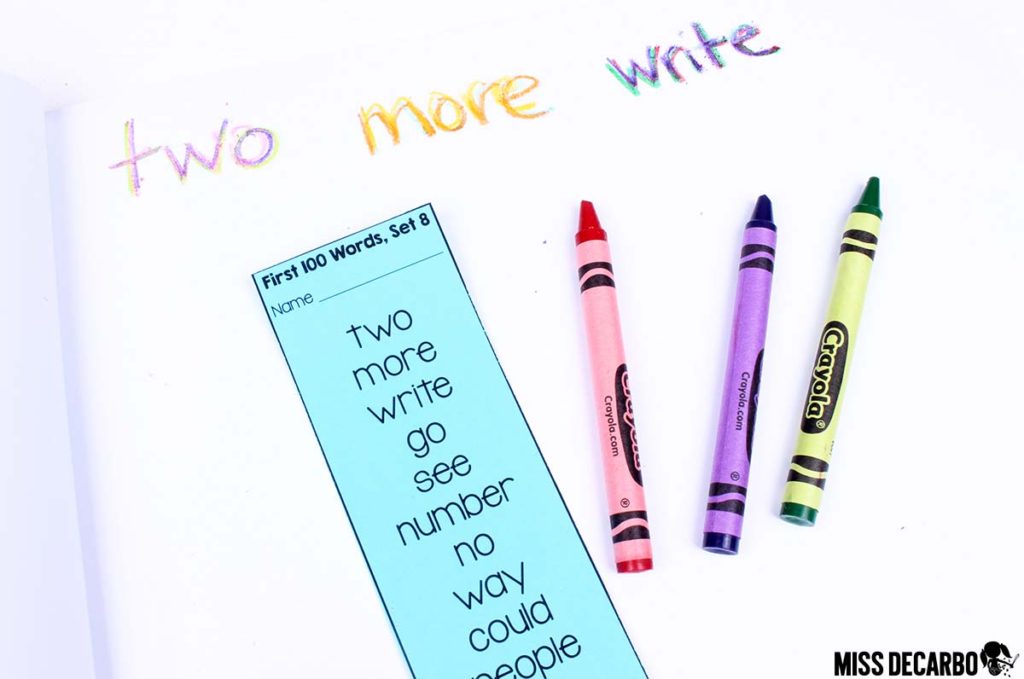
Rainbow Writing Remix
When Rainbow Writing gets “old,” it’s time to mix it up! Simply throw a die into each word work bin the week after your kiddos Rainbow Write their words. This time, the kids must roll the die. Whatever number they land on is the number of colors they have to use to Rainbow Write their word. So, if they roll a six like in the photograph below, they must choose SIX crayons and write the word six times, each time tracing over the word. Want to mix it up even more?! Put a set of dice in your word work bin. Now, the kids have to SUBTRACT the larger number from the smaller number to figure out how many colors they must write their sight word with. (Then, turn around and do a sneaky teacher laugh, because you just mixed math and writing into one super fun word work activity!)
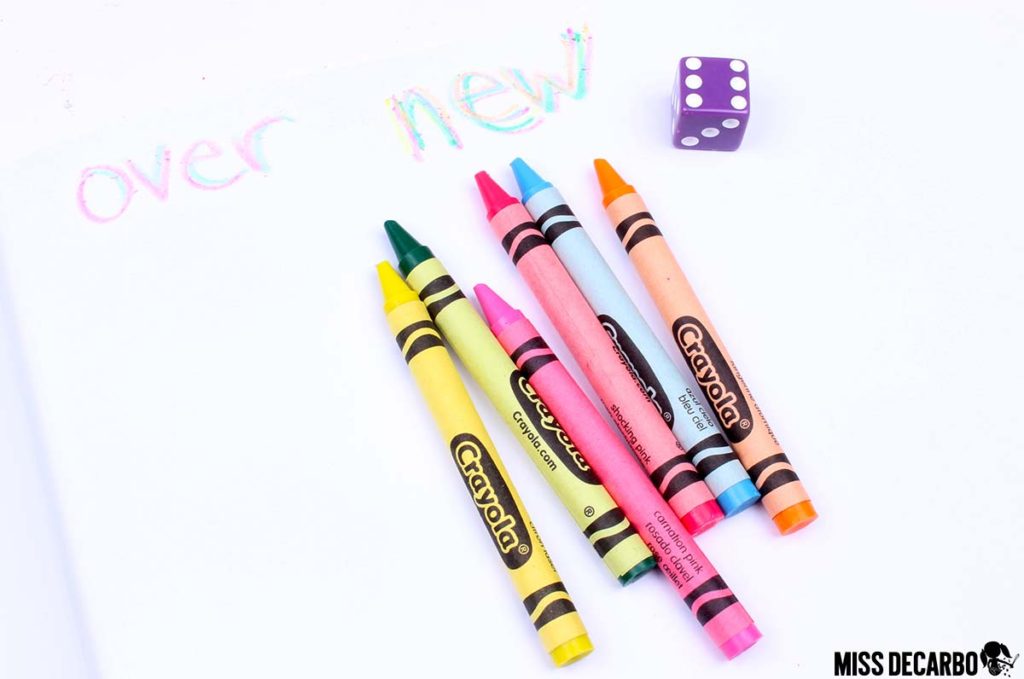
Crazy Crayon Day
Let’s face it. Sometimes you just need an easy word work center for the week because there’s not enough coffee in the world to make you want to come up with a crazy out-of-the-box idea. That’s where Crazy Crayon Day (or week) swoops in. Allow me to remind you of an empowering fact: We teach little ones. That means that things don’t have to always light up, sing, and dance in order to be fun and exciting. Sometimes, all you need is something different. If you go to Target, Walmart, or Amazon, you’ll find that Crayola Crayons has come up with really neat boxes of crayons these days! They have silly names and fun colors that you won’t find in an ordinary box of crayons. I snapped a picture below of the ones I found a few weeks ago: Mermaid Shimmer, Neon Dream, Neon Soup, Dinosaur Roar, and Over the Rainbow. Teacher friends, there is nothing secretly exciting about these crayons – unless you’re a kid. If you’re a kid, getting a write your sight words with DINOSAUR crayons or MERMAID SPARKLE crayons makes an ordinary school day the best.day.ever. Throw your Crazy Crayon boxes into your word work bin, have that second cup of coffee, and marvel in the fact that you just became the coolest teacher in your building!
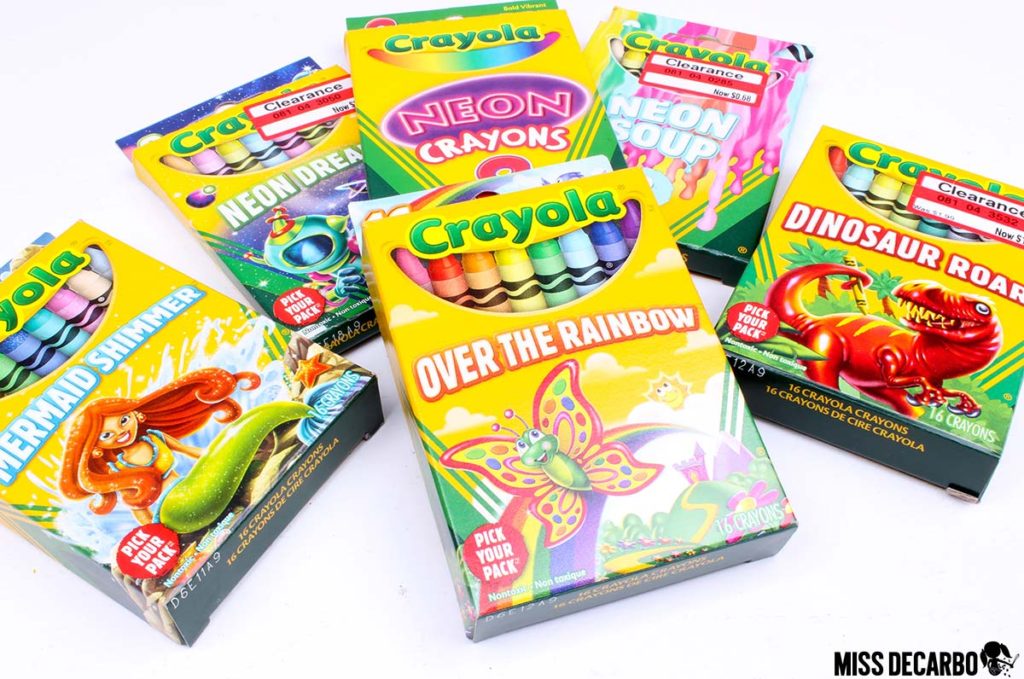
Below are some links to some of our favorite boxes of “crazy crayons”:
- Glitter Crayons
- Dinosaur Roar Crayons
- Mermaid Shimmer Crayons
- Neon Soup Crayons
- Metallic FX Crayons
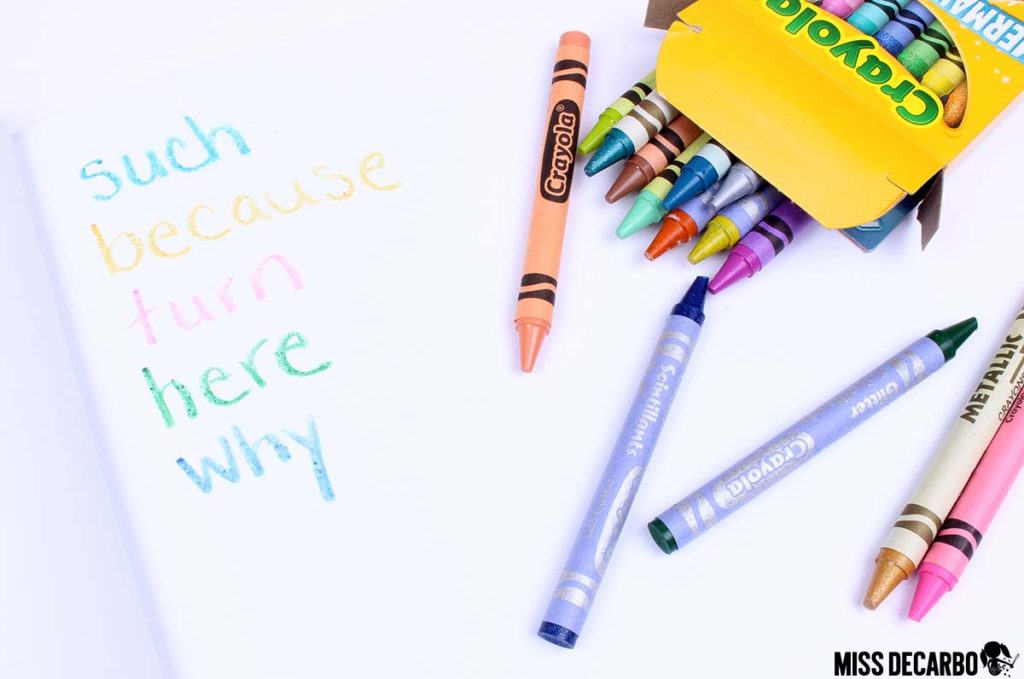
Gel Boards
Does the toy below look familiar? I used to play with these magic slate boards in the car as a little girl! When I saw them at a Cracker Barrel Store a couple of years ago, I knew they would be a perfect word work center for my students. They can be a little tricky to find these days, so if you see them around, snatch them up! The students will simply use the plastic stick to write their words or sentences on the gel pad, and then lift the plastic cover page to “erase” the word and begin again! You can find similar ones to the one I have pictured below on Amazon by clicking HERE to purchase a set of 12. (You could even split the cost and pack with a teacher friend!) I also liked this pack of mini ones that come as a pack of six. You can find the mini boards HERE.
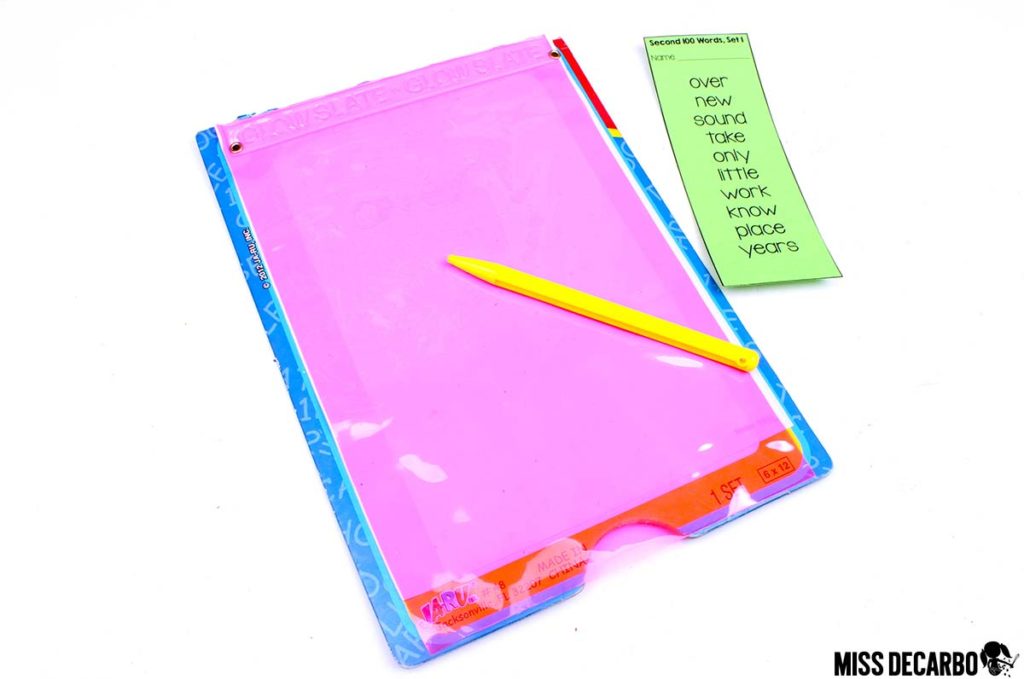
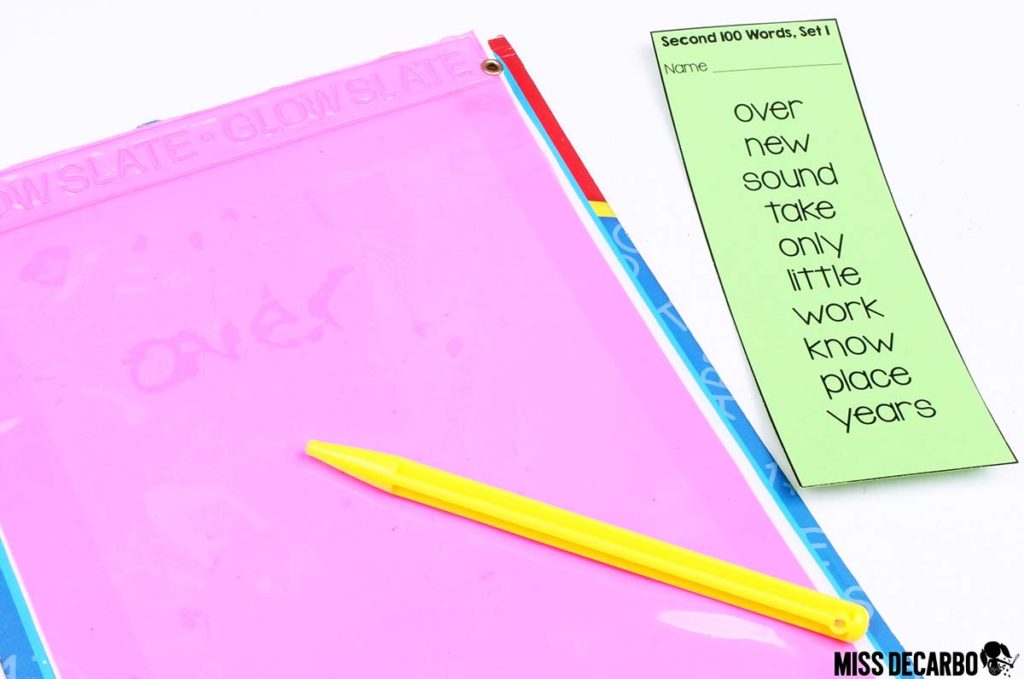
Magnetic Letters
This is a classic word work activity, but always a favorite for my students. I want to emphasize that you do not need to have huge, bulky magnetic cookie sheets in order to use magnetic letters! We’ve used them on the floor, right on our paper, and we’ve even just arranged them on our dry erase boards. When I do use magnetic letters, I also like to have my students write the word in their word work notebook, too. This provides a “built in” recording sheet for the activity. After we practice building our words with the letters, I introduce the center again with a twist. This time, the student must build the word with their magnetic letters, but then write a complete sentence using the word in the notebook.
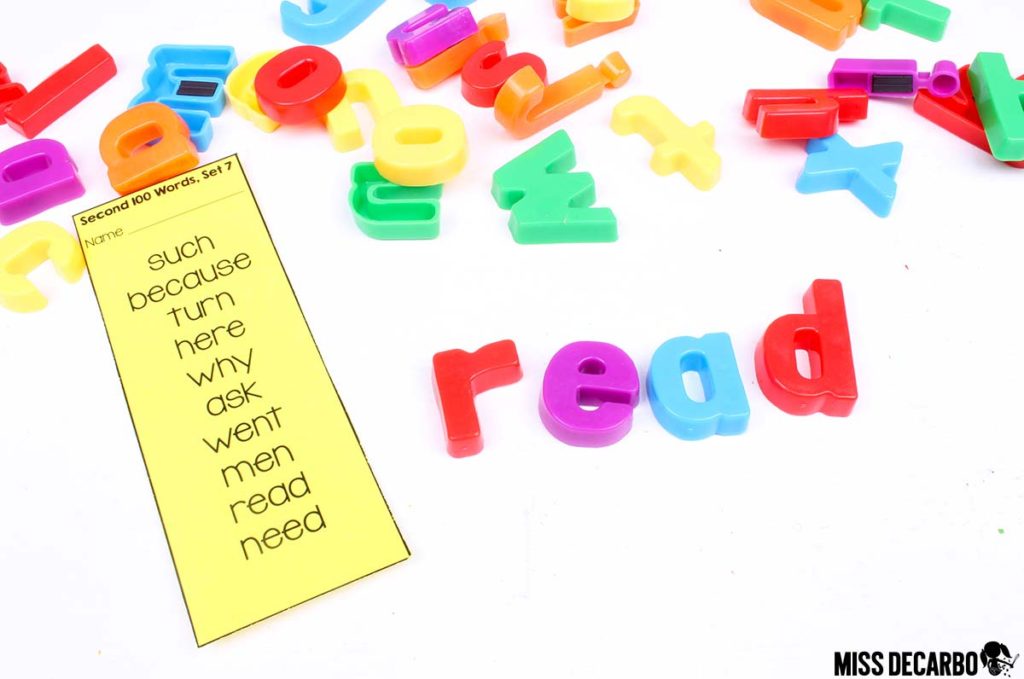
Play-dough Stamping
I’m a big believer of recycling materials and adding a little twist to make an old center NEW to students. After your students have completed a week of their word work activity with the magnetic letters, it’s time to throw some play-dough into the bin WITH the magnetic letters. (I would also throw in a paper plate for them to work on, just to keep things tidy.) This week, the students will make a “pancake” with their play-dough. Then, they will use the magnetic letters to “stamp” the word into the play-dough. Some teachers have asked me if my magnetic letters get “messy” with the play-dough, but I’ve really found that the play-dough doesn’t stick to the plastic letters too much. I teach my kids to stamp them straight down into the play-dough to keep the letters clean. (We love this neon play-dough pictured below. You can find it here.)
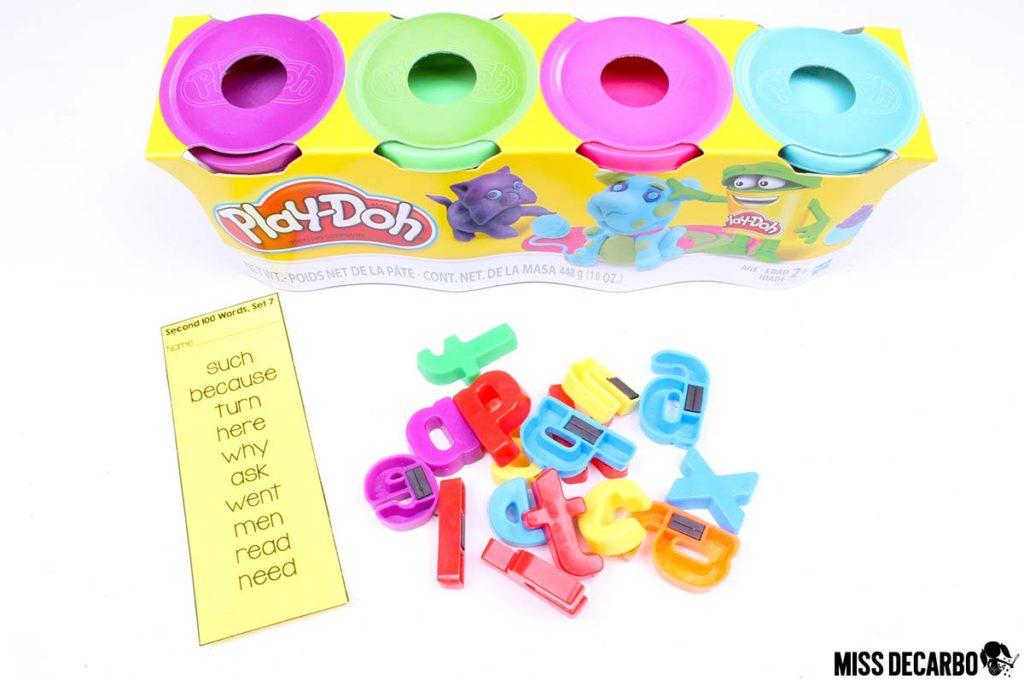
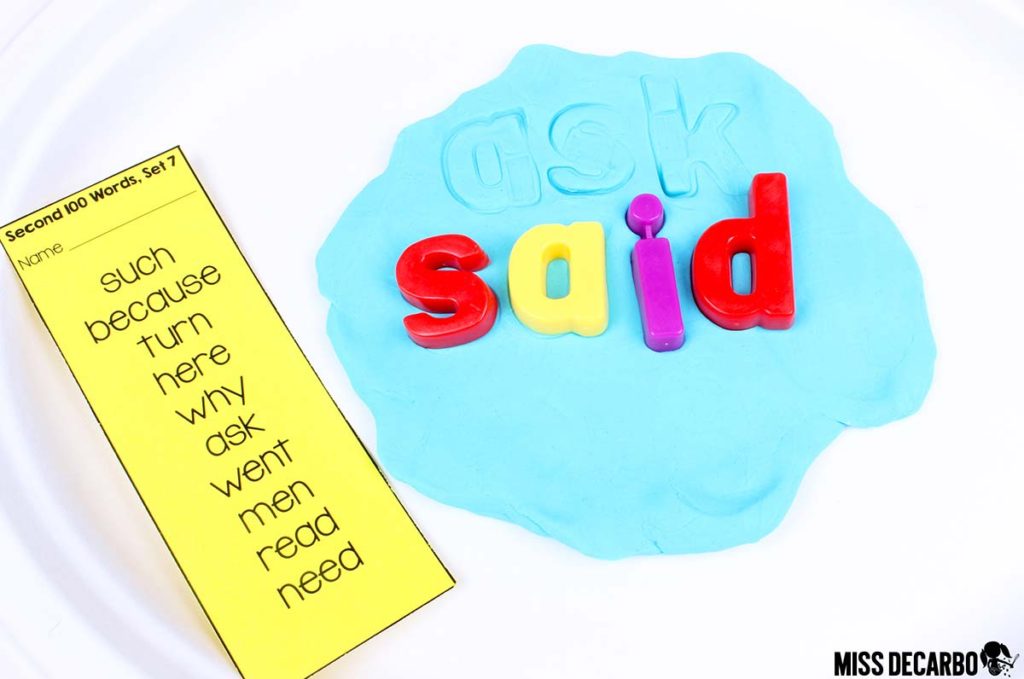
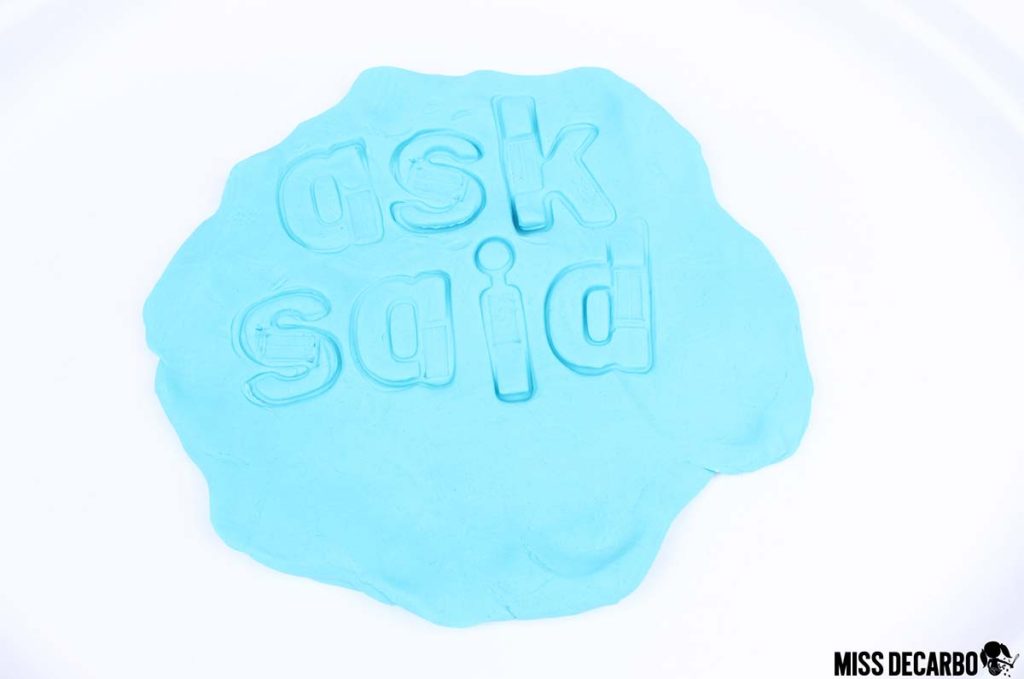
Desktop Word Work
Here’s another EASY word work activity that only involves a desk/table and a dry erase marker. Mix things up by throwing only a dry erase marker into your word work bins and telling students to practice their words by writing on their desks! They will think it is so much fun that they won’t even realize how much sight word spelling practice they are squeezing in. You can see from the pictures below that my students really love seeing how much they can fill their desk up with words.
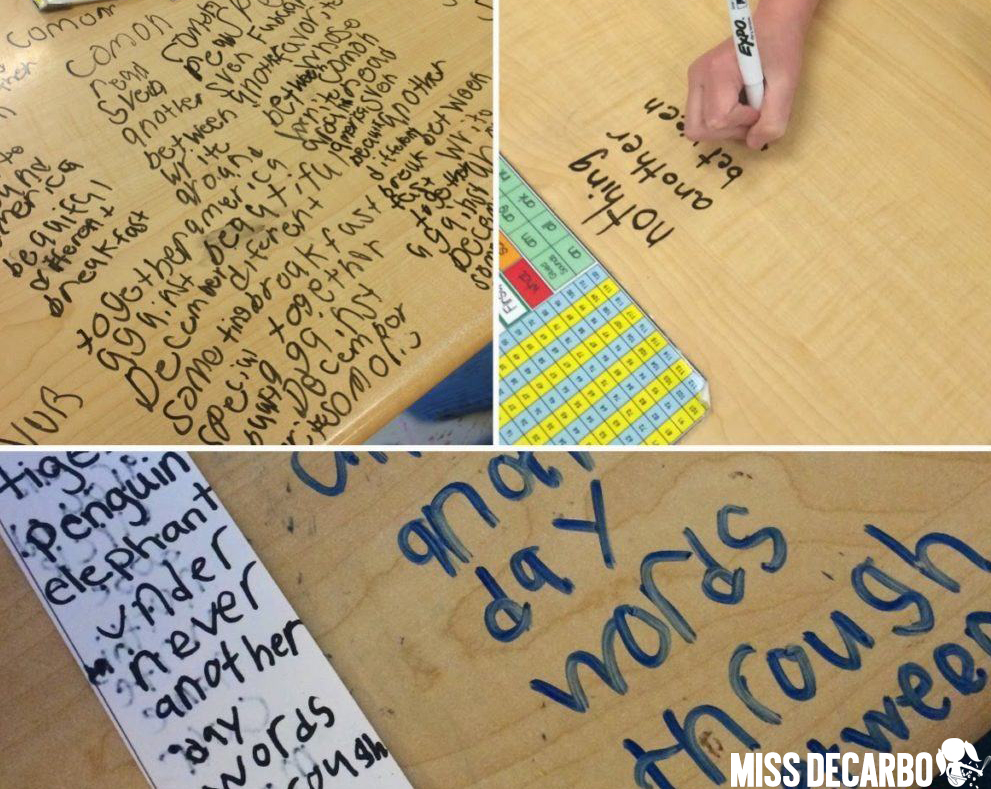
Secret Words
Secret words are a personal favorite word work activity of mine. The only materials your students need are a white crayon and a pack of markers. First, the student will write the sight word with the white crayon. Then, he or she will choose a colored marker and “color over” the sight word to “reveal” it! You can use crayons to color over the word, but I’ve found that markers make the word show up much better. My students LOVE this activity!
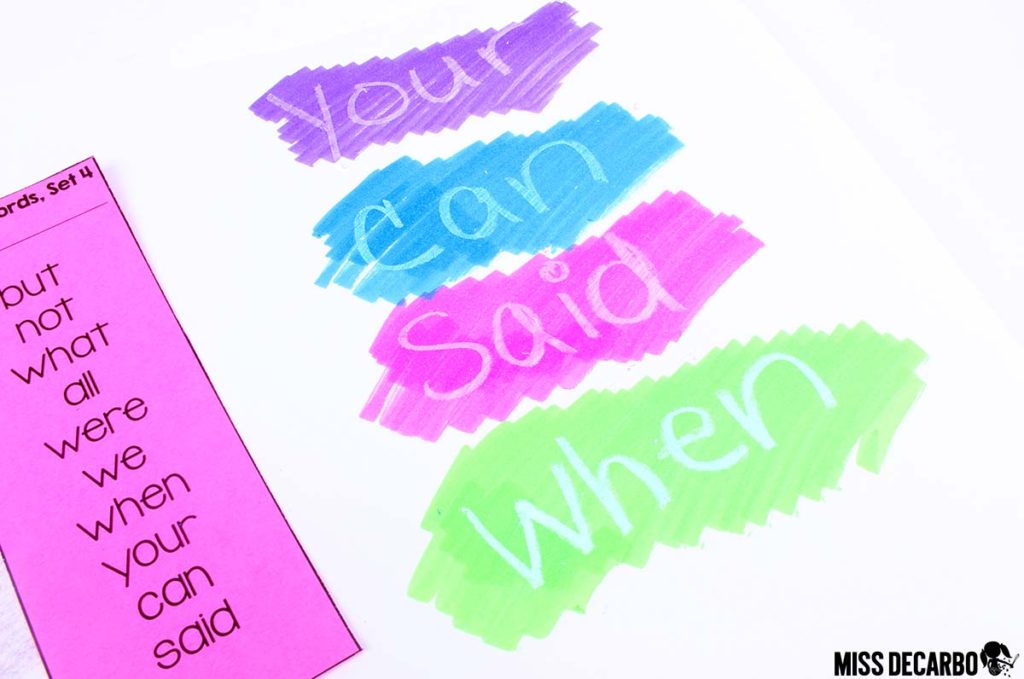
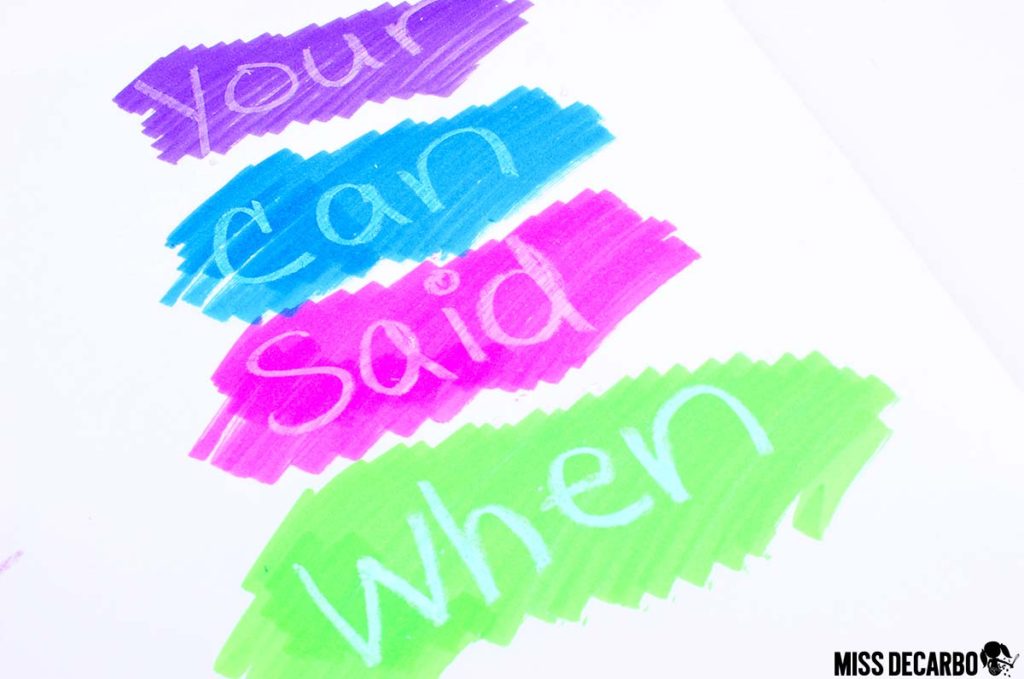
Word Work Wheels
My Word Work Wheels are the perfect solution when you want to add novelty and engagement to your word work bins. Simply toss a Word Work Wheel of your choice and a box of crayons into the bins. Add a pencil and a paperclip for the “spinner” and you are good to go! There are SIX different Word Work Wheels to choose from and they come in a color and printer friendly version. Each Word Work Wheel has different tasks the students will complete for their sight word (or any word), depending on the spot the spinner lands on.
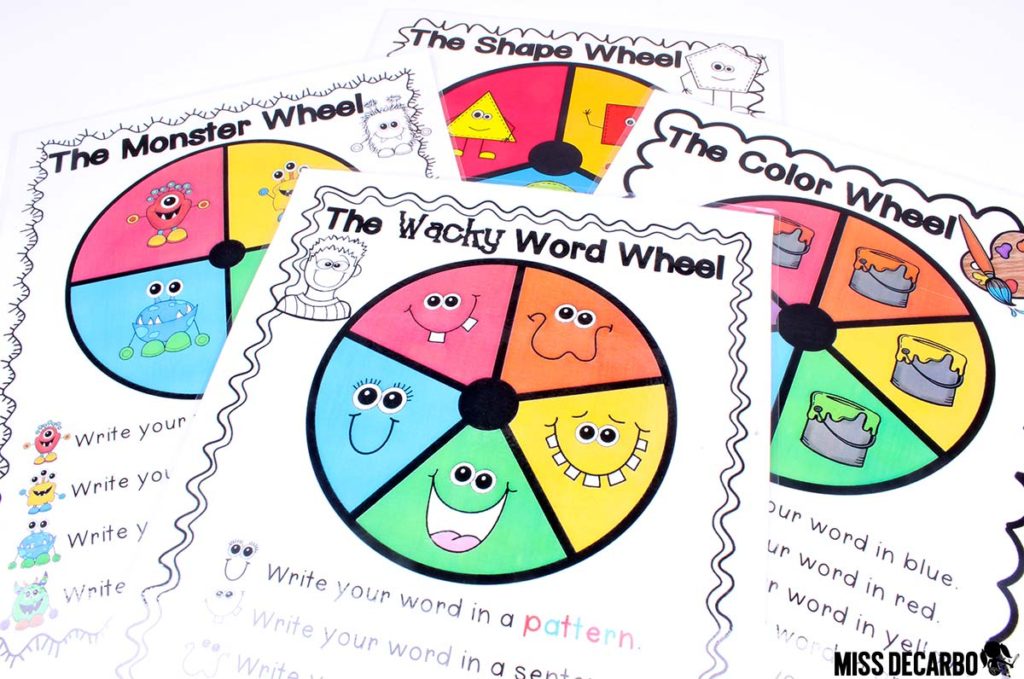
The Monster Word Work Wheel (pictured below) is always a class favorite. Students will spin the spinner and write the word with box letters, bubble letters, dots, or in bold letters. Then, the child spins The Monster Wheel again to decide the fate of the next word on his or her sight word list.
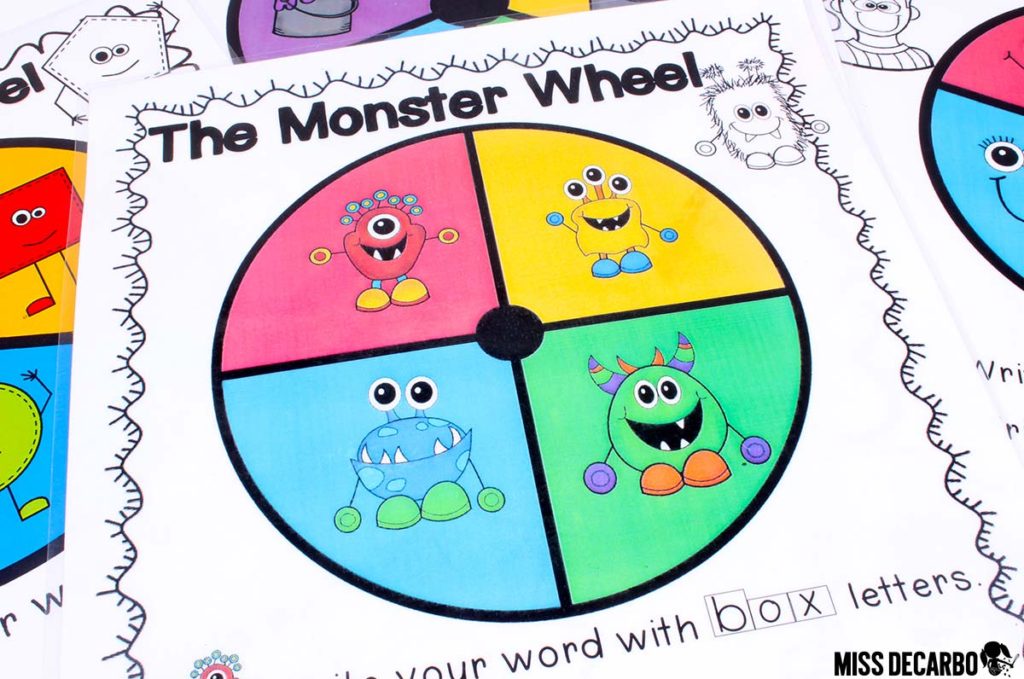
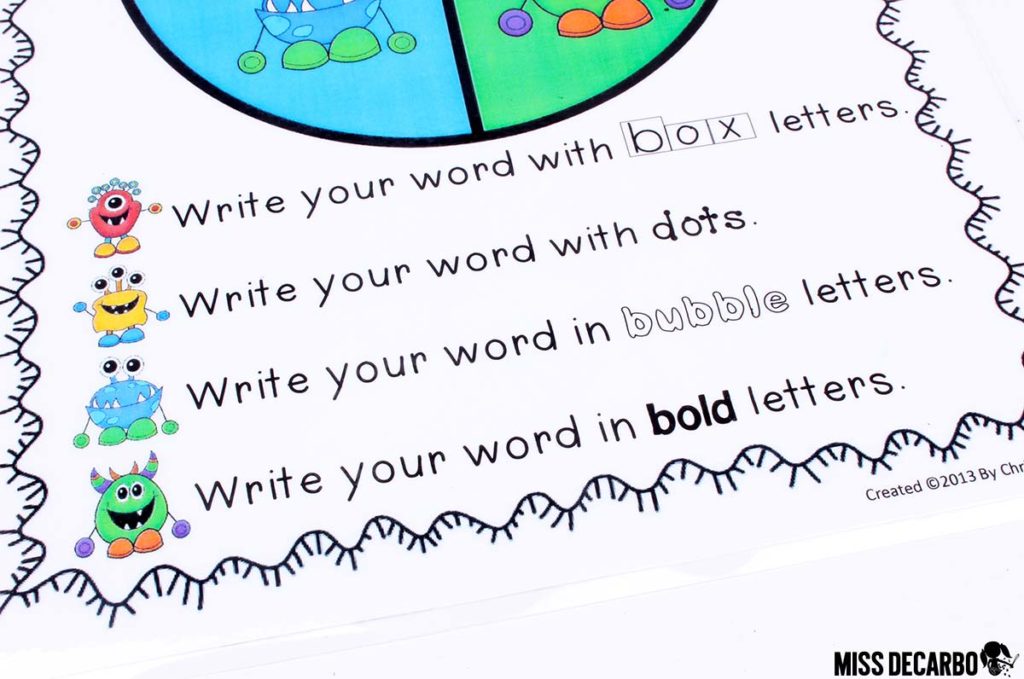
The Shape Word Work Wheel is a great one to use at the beginning of the year. The students will write their sight word, and then spin to decide whether to draw a triangle, square, or a circle around the word to create “shape words.” So simple, but so fun for kids.
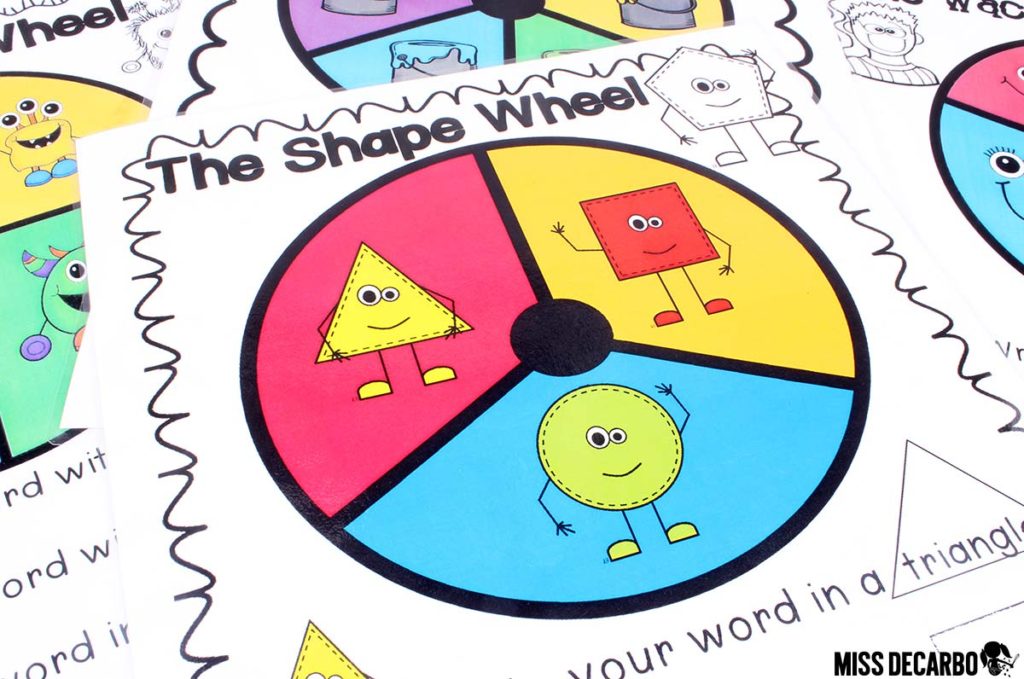
For the Color Wheel (pictured below), students spin to determine what color to write the word in. You can use crayons, colored pencils, or markers for this activity. I always start off with crayons, and then throw The Color Wheel back into the bins several months later with a box of markers. My first graders always love working with a different material as they complete a favorite activity.
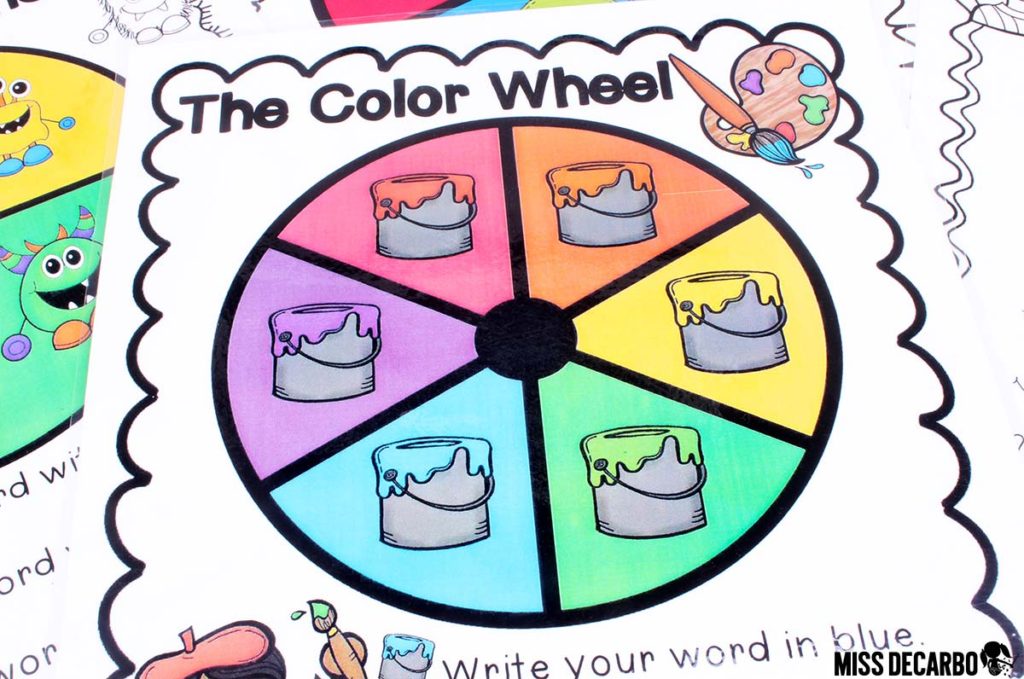
Chalkboard Word Work
We live in a very Dry Erase Board world, so while it may not seem thrilling to adults, chalk is a great material for your students. As a quick side story, two years ago I came across my very first student who truly didn’t know what a chalkboard looked like. I was so sad, until I started to think about it. Why would she? Our school has dry erase boards and Smart Boards throughout the building, so unless she had seen or used a chalkboard at home, she would not have known what it was. I found a set of chalkboards online HERE and I’ve since used them every year.
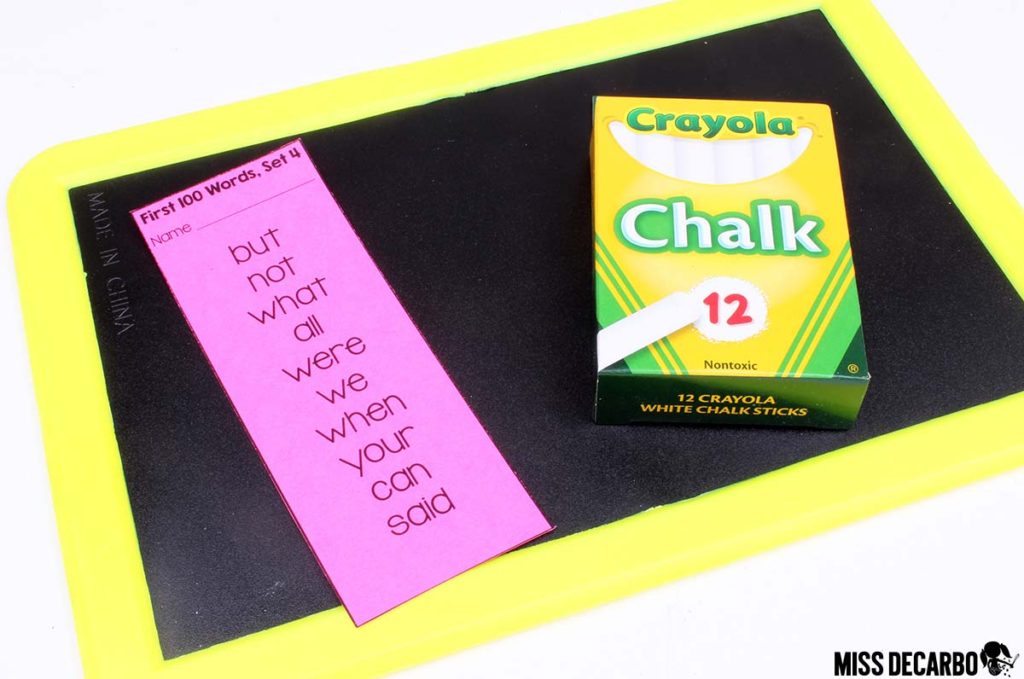
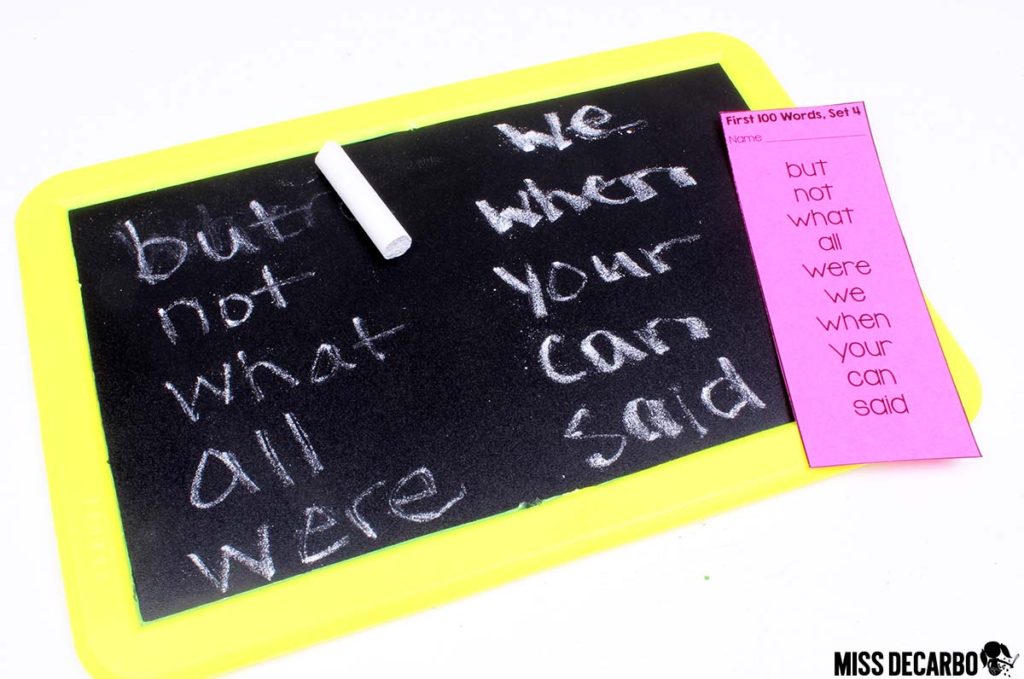
Can I give you a secret management tip? Always start your Chalkboard Word Work center off with plain, white chalk. Then, when you bring this activity back to your word work center months later, swap out the plain, white chalk for colorful sidewalk chalk. Your students will think the Chalkboard Word Work center is better than ever!
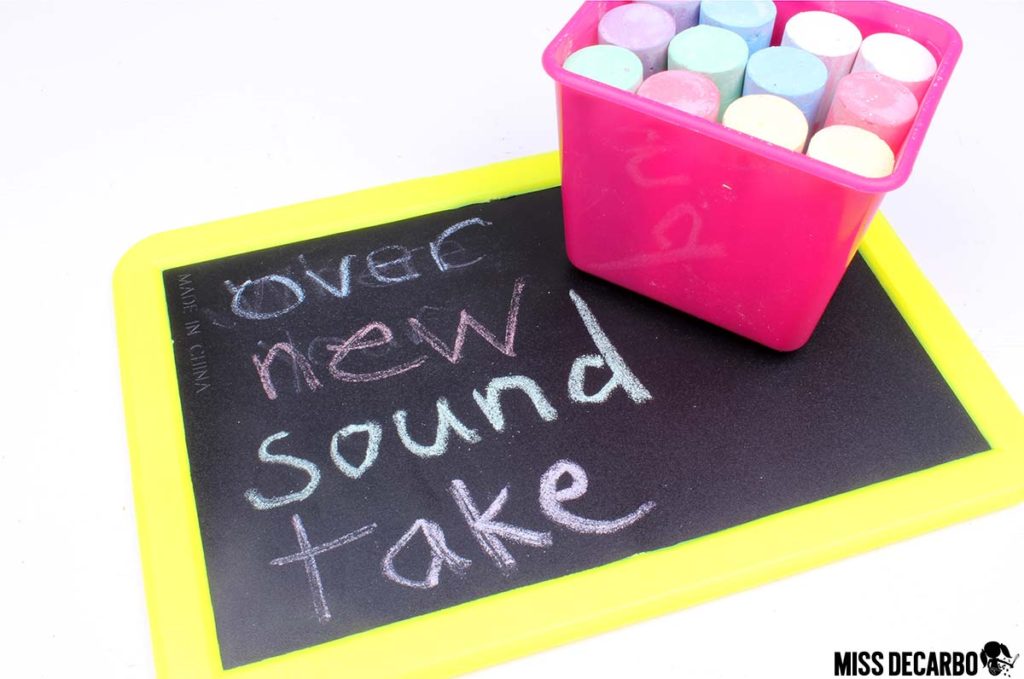
Word Work Mats
I created this Word Work Mat (pictured below) as an exclusive Facebook Live Freebie last year. I only let a handful of people snatch it up, so I wanted to include it for everyone else to now use with their students! I place these Word Work Mats in these neon dry erase pockets for an instant word work center that students can reuse again and again.
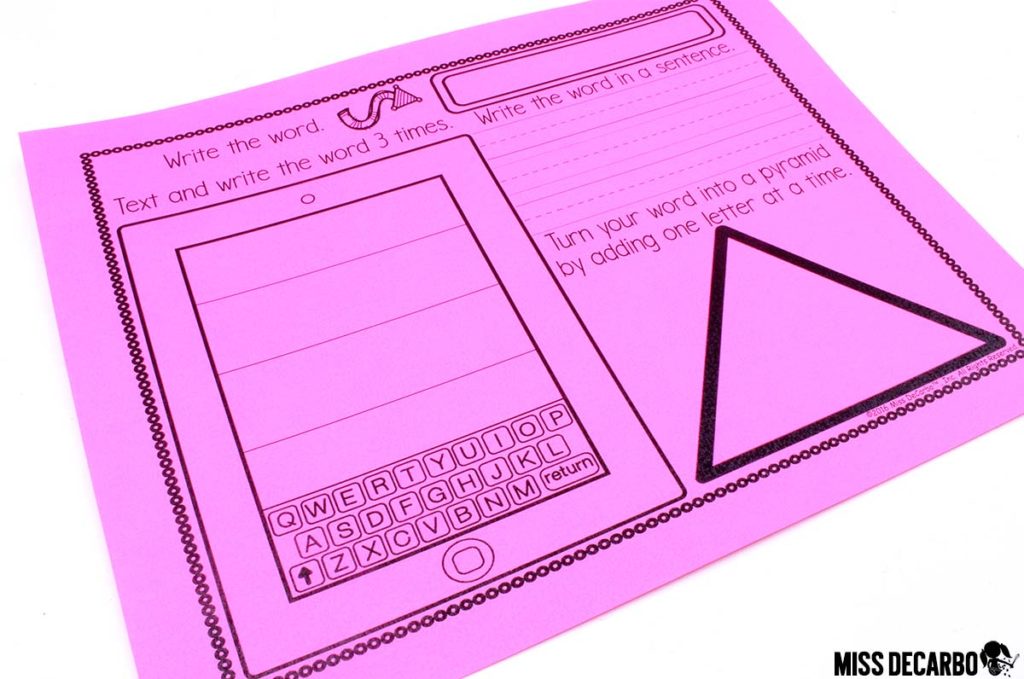
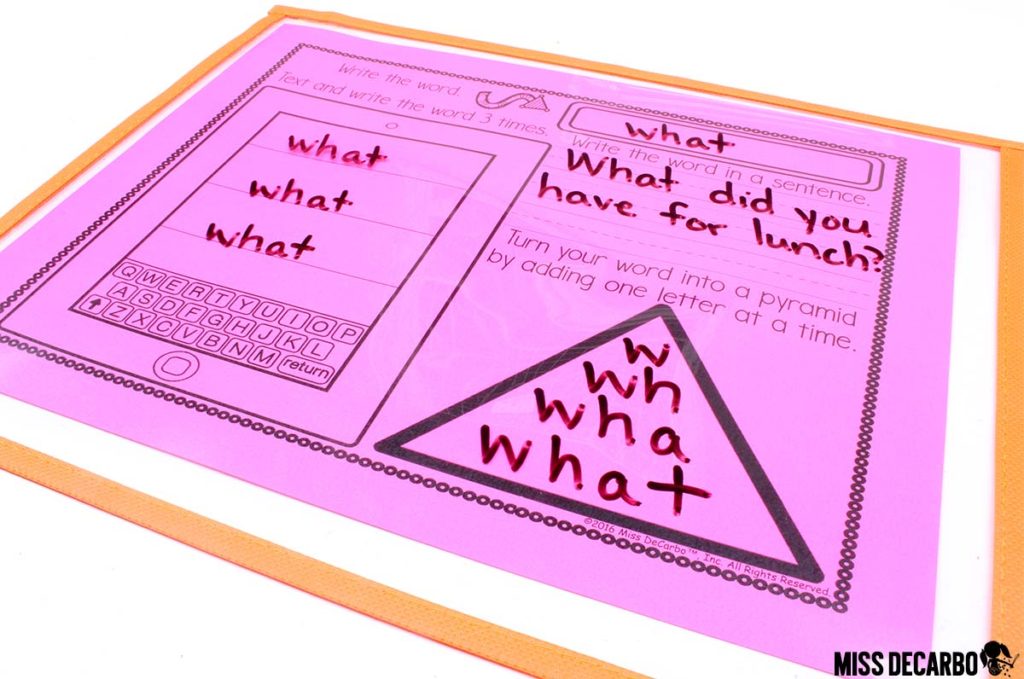
If you’d like to use this Word Work Mat, you can download it by signing up for my mailing list and receiving it as a FREE gift!
Get this word work freebie!
Sign up below and get teaching tips, exclusive freebies, ideas, and news from Miss DeCarbo! Together, let’s create intentional classrooms of engaged, critical thinkers!
Thank you for subscribing!
Dry Erase Word
Here’s another classic word work activity – dry erase words! Always start off with plain, black dry erase markers, so that you can up the fun by throwing neon or colorful dry erase markers into your bins in the future!
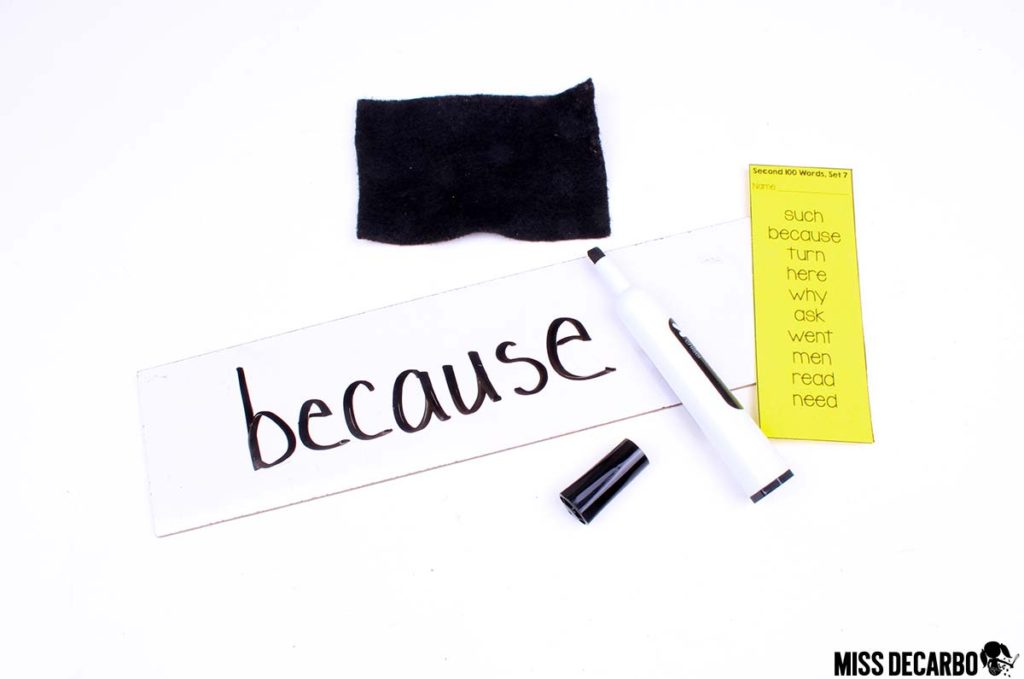
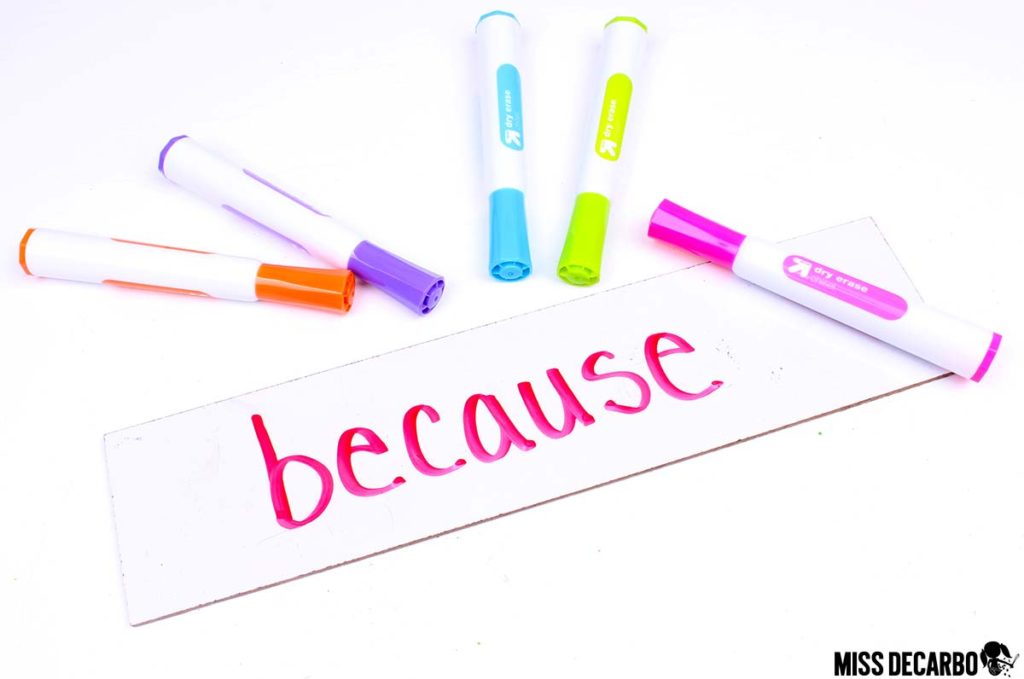
Pyramid Writing
Pryamid Writing is a word work activity that I teach early on in the school year. To Pyramid Write your sight word, simply write the first letter of the word onto the paper. Then, re-write the first letter, and add on the second letter in the next row. Keep writing the word, adding one more letter each time. This transforms the word into a pyramid shape. It’s also a great strategy for students who need to work on visual memorization skills while learning how to spell sight words. The repetition helps the students memorize how the irregular sight words are spelled.
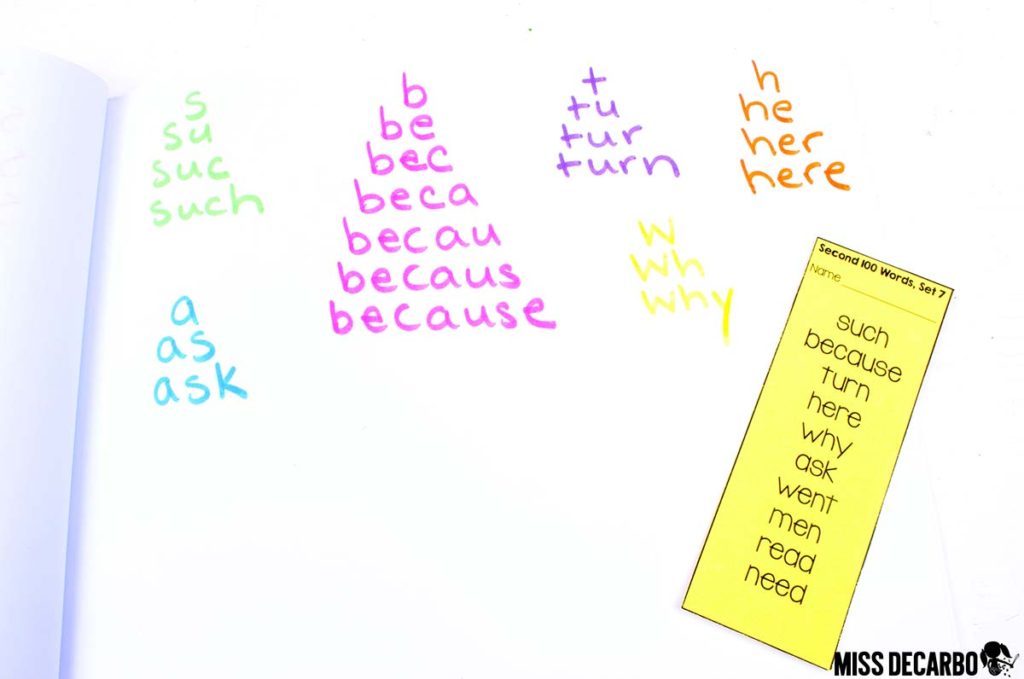
Stamp-a-Word
My students love to stamp their words with an ink pad and my lowercase alphabet rubber stamps. I love to use these Lowercase Alphabet Rubber Stamps in the picture below. You can find them by clicking here. Another great pack of alphabet stamps can be found here.
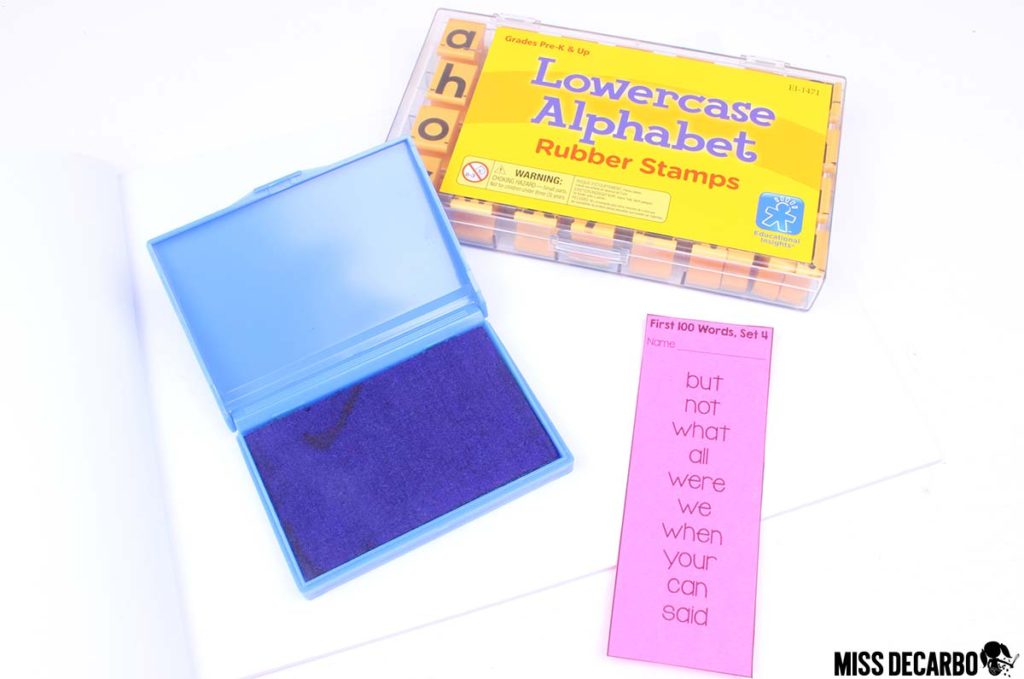
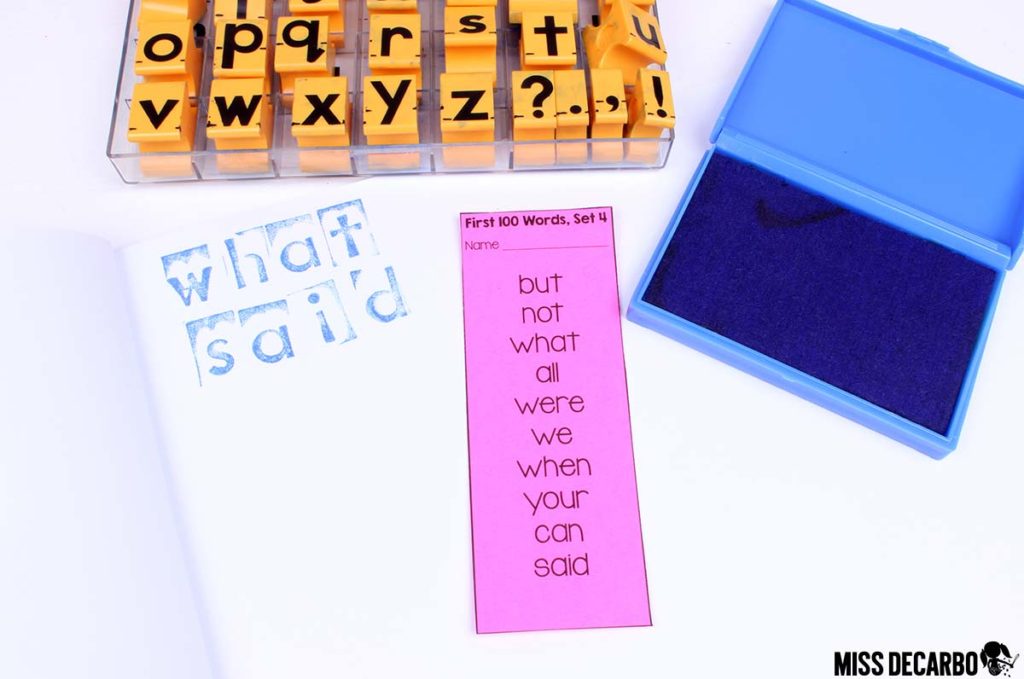
Wacky Word Work Cards
My Word Work Wheels pack (found HERE) also contains 15 Word Work Activity Cards as a bonus resource. These are fun to pull out towards the end of the year, when your students have had experience practicing with all of the Word Work Wheels in the set. To set up this word work center, I simply print the word work task cards and throw them into the word work bin with a pencil and a box of crayons. You can also hole punch the corners of the cards and make a Word Work Ring that you can toss into the bin, so that the cards stay nice and tidy. Students simply pull out a task card and follow the directions on the card as they practice spelling their word. They can write all of the words using that specific task card, or, they can pull out a new task card for every word on their list. This is a great word work center that I keep in the bin for at least two weeks, because there are so many different options and activities for them to choose from.
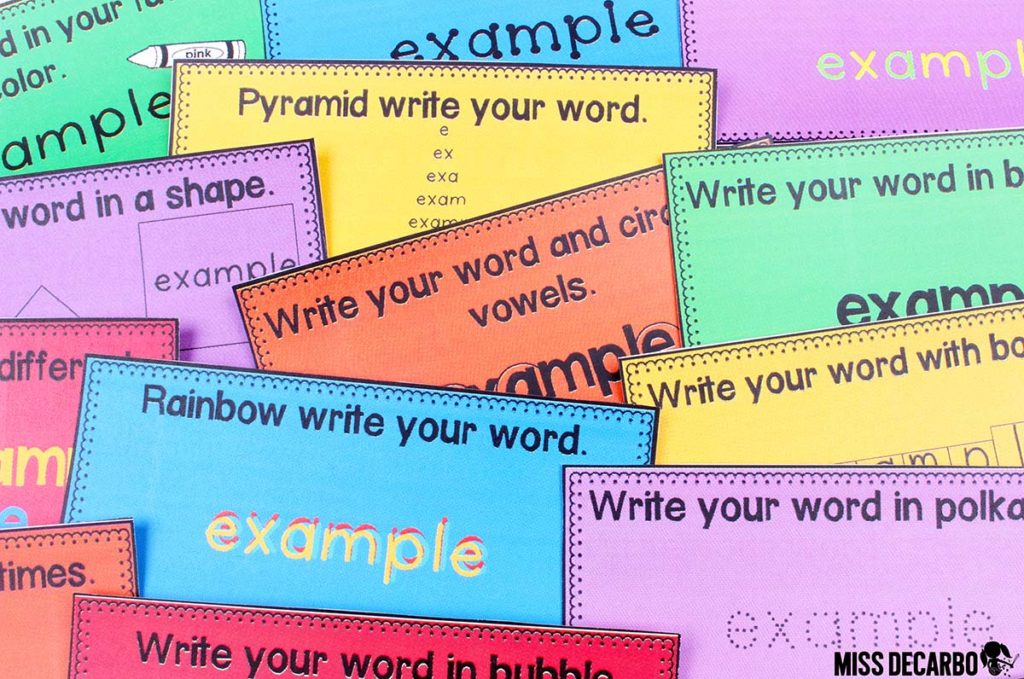
Keyboard Practice
I love using real keyboards in the classroom for word work. Ask your technology coordinator, or even your neighbors, a corporate company, or your church to donate their old keyboards whenever they decide to upgrade their computers. Having students practice their typing skills as they practice spelling their sight words is a great way to integrate technology skills into the classroom. (No, the keyboards aren’t actually hooked up to the computer. However, if you don’t have a class set of computers, getting hands-on typing practice is still valuable within the classroom!) If real keyboards are not an option, I created another work work mat for you to use with your students. To use the Keyboard Practice Page below, the students will “type” their word using the printable keyboard at the bottom of the page. Then, he or she will write the word using a dry erase marker at the top of the “computer screen.” (I slip these word work mats into dry erase pockets so they can be reused over and over again for new words.) The student will type and write the word three times before erasing the board and repeating the activity with the next word on his or her sight word list!
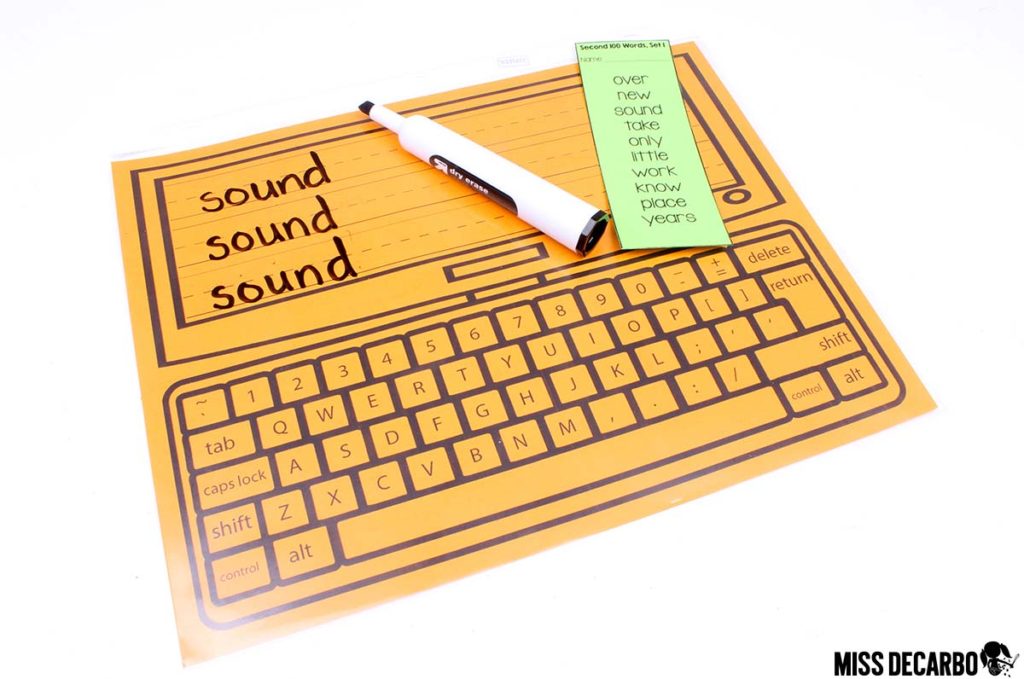
You can also complete this activity by having students type and write the words in a sentence on the “computer.”
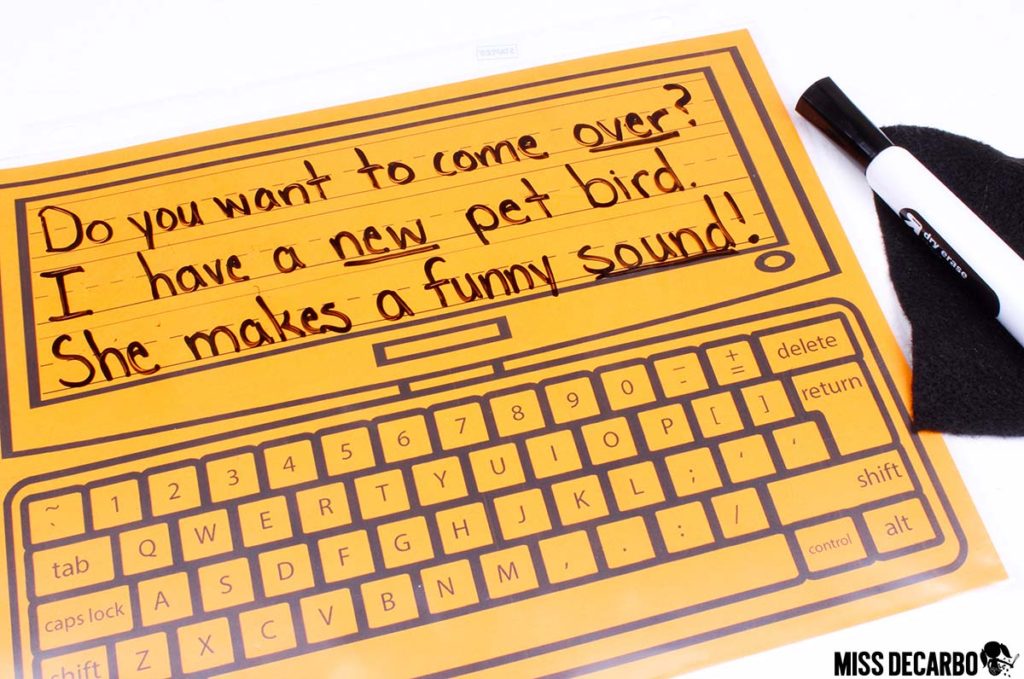
If you’d like to use this Keyboard Word Work Mat, you can download it for FREE at the bottom of the post.
Sight Word Spinner
I shared this Sight Word Spinner with teachers who attended my small group workshops during last year’s SDE events. Now, I want to share it with you! The student will spin the spinner, and complete one of the five tasks listed to practice their sight word. They will either rainbow write the word, write it with “magic ink” on the table (using their finger), clap out the word as they spell each letter aloud, tap their nose every time they say a letter to spell the word, or write it in the sky with their magic finger. Then, the student will spin the spinner again to complete a new task with a new word on the sight word list. (This is also a cute activity to use at the small group table to practice your focus words for the week!)
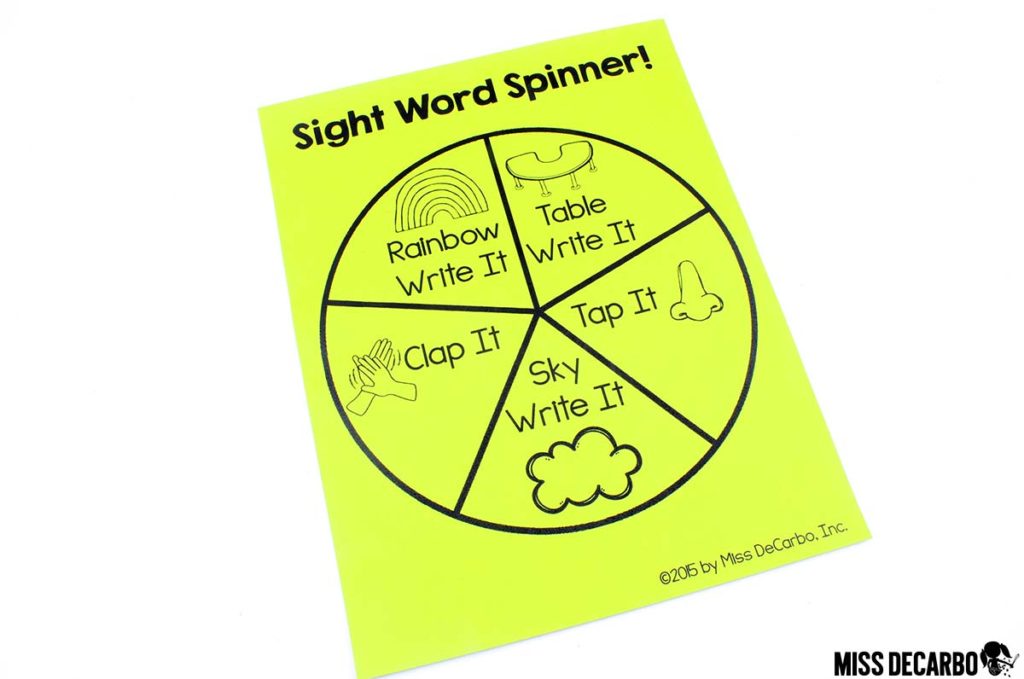
If you’d like to use this Sight Word Spinner Word Work Mat, you can download it for FREE at the bottom of the post.
Are you ready to grab your three word work mat freebies? By clicking on the image below, you can sign up and join my email list to access the three free word work activity mats. By joining my email list, you not only get the freebies, but you are invited to be a part of my exclusive “Miss DeCarbo Teaching Family!” This means you’ll receive my latest blog posts straight to your email inbox, as well as exclusive freebies that I send out ONLY to my email list, and special notifications of events, announcements, and sales happening on the site! (If you’re already a part of my newsletter group, you’ll still want to click the image below to grab your freebies. Don’t worry – you won’t receive my newsletters twice, and you can use the same e-mail address you always have!)
There you go, teacher friend! Over 20 word work ideas for sight word spelling in your primary classroom. I hope this blog post was helpful and you were able to grab a new idea (or two or three!) for your word work centers. If you want to pin this blog post to your Pinterest board so that you do not lose the post and are able to refer back to it year after year, feel free to use the image below as your pin. (Or, use the image below to pin and share it with your teacher friends!) Until next time…Happy Learning!
